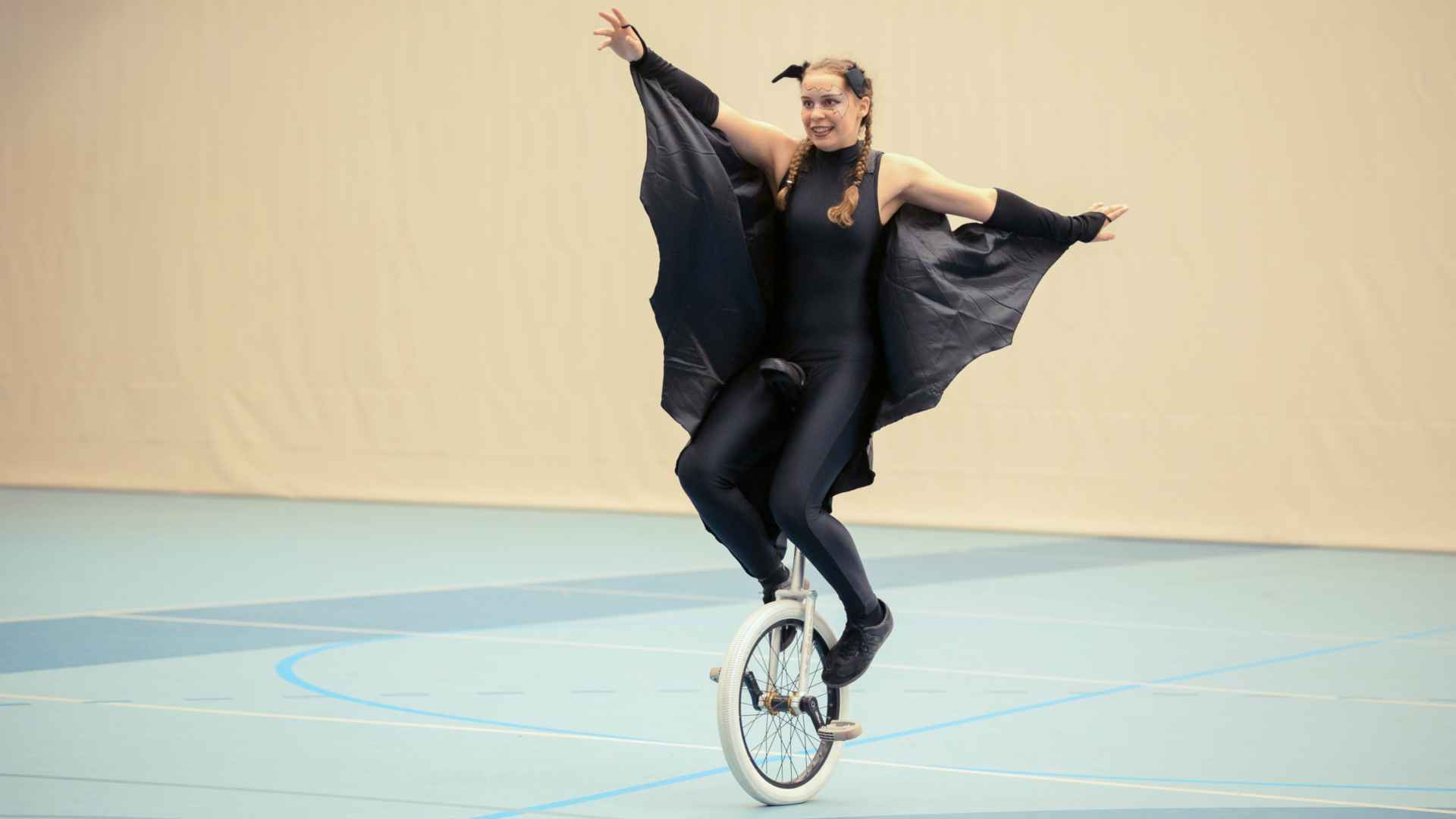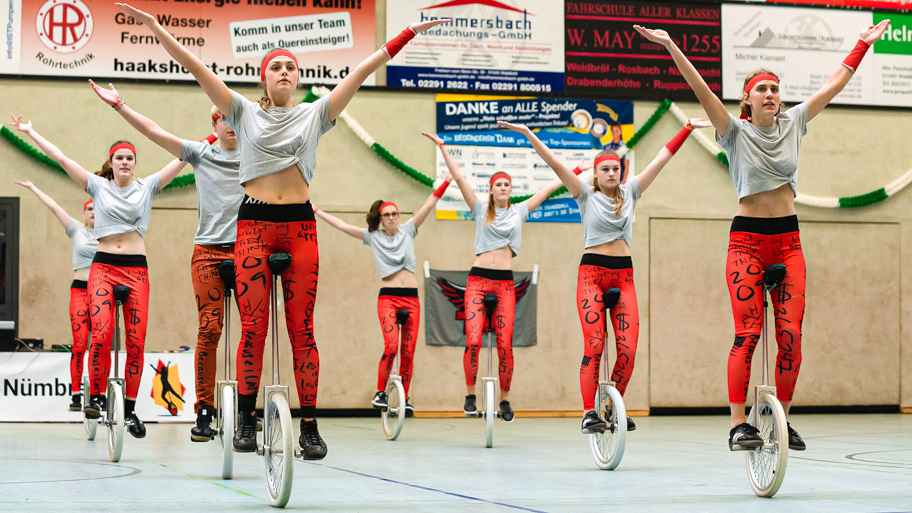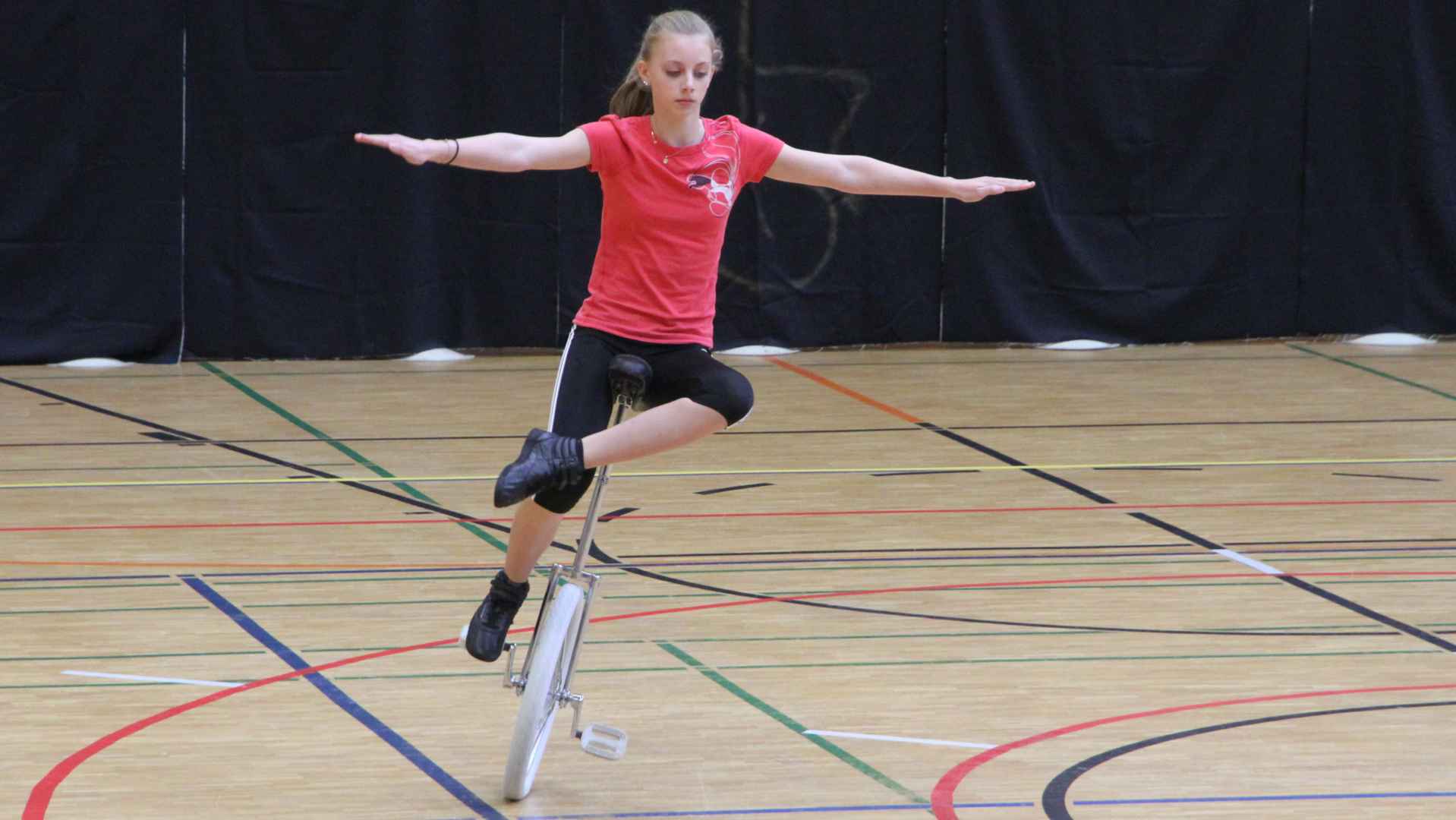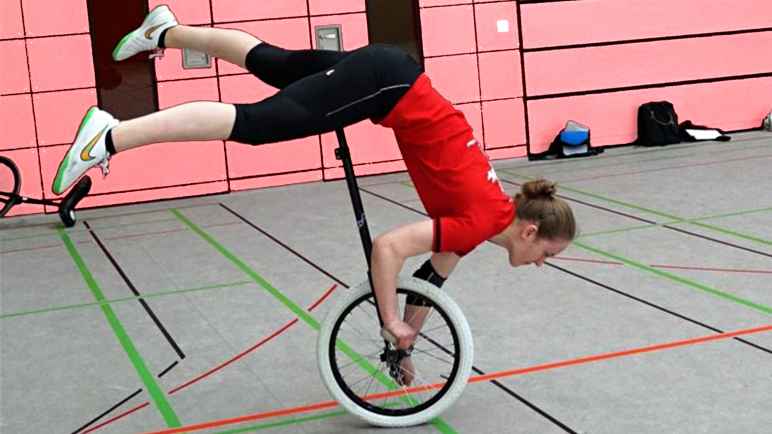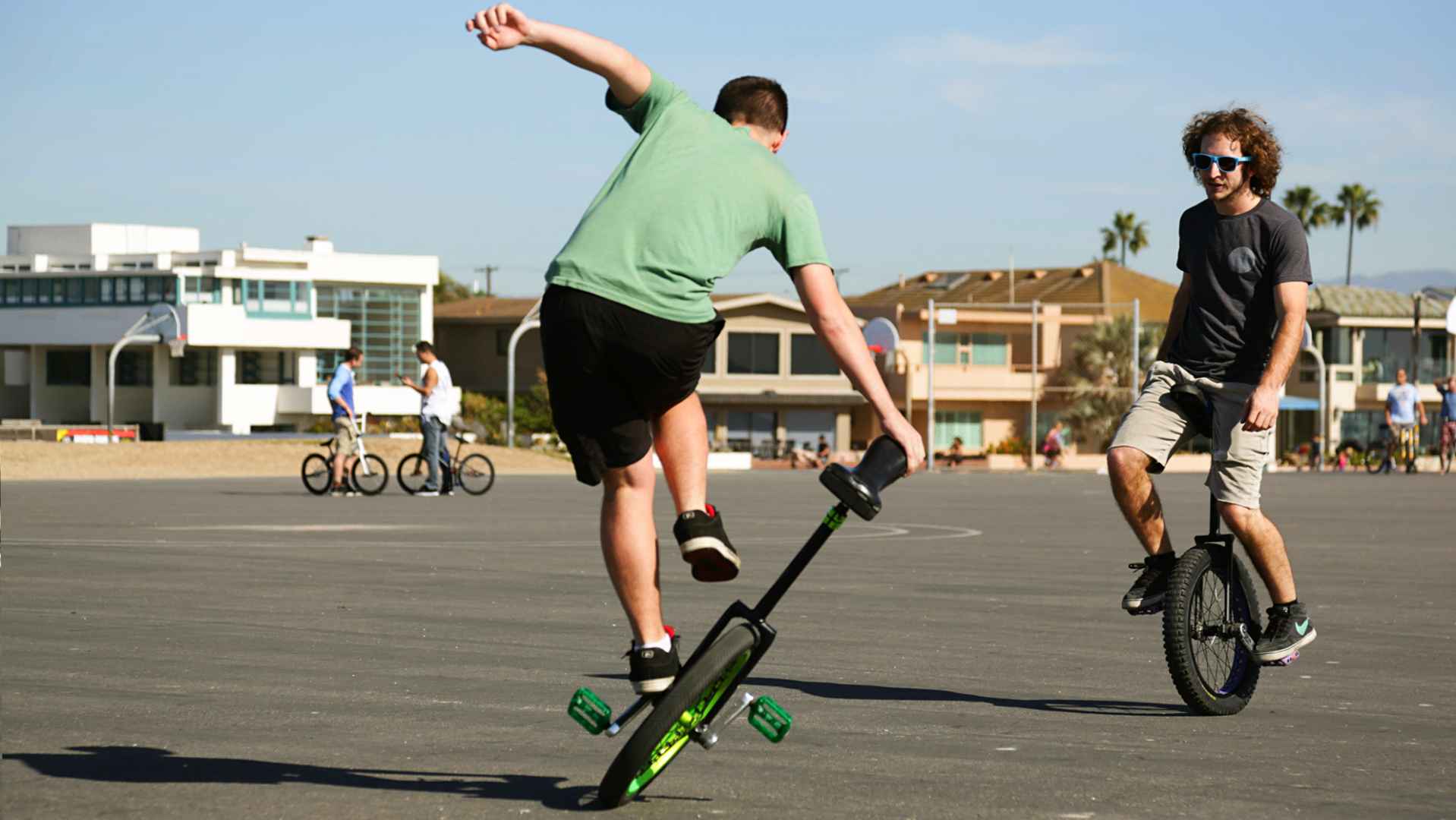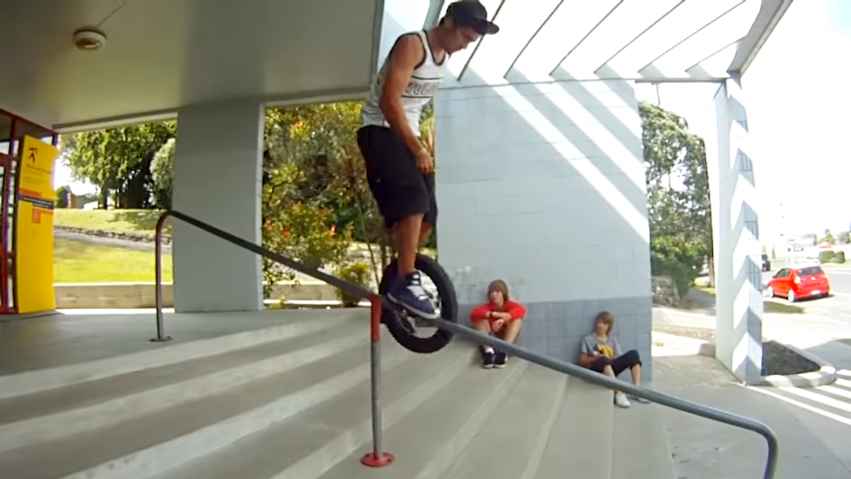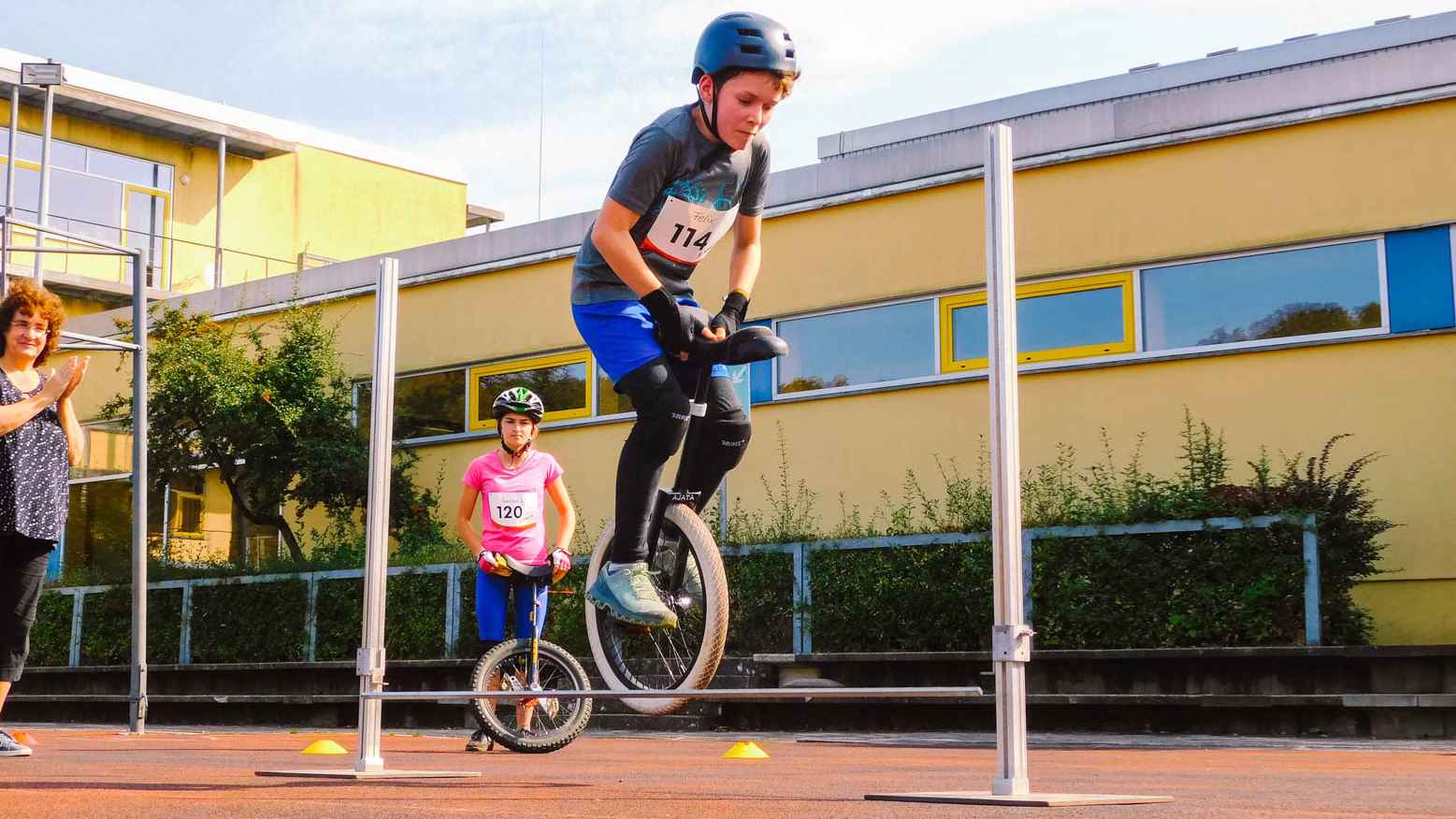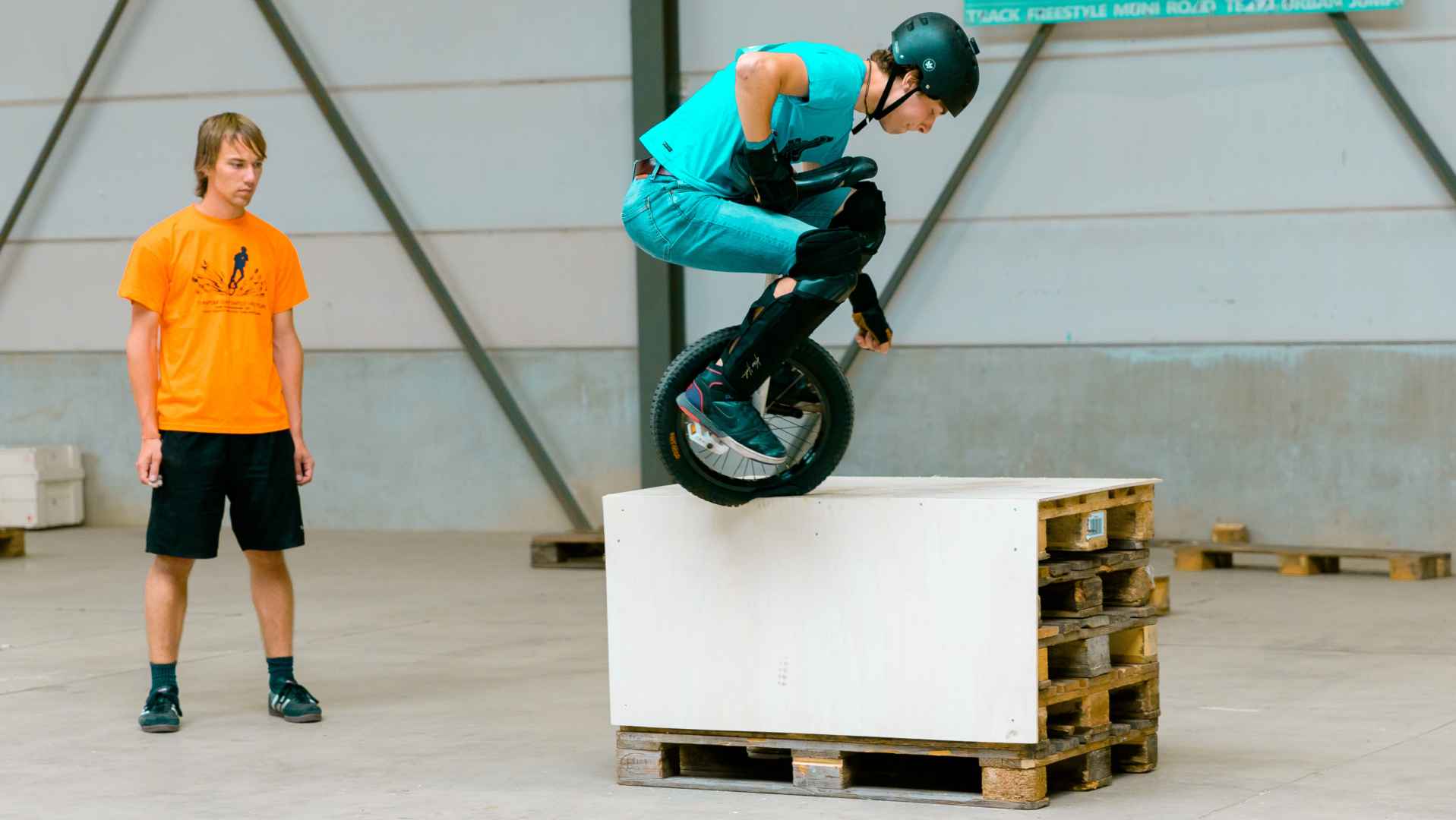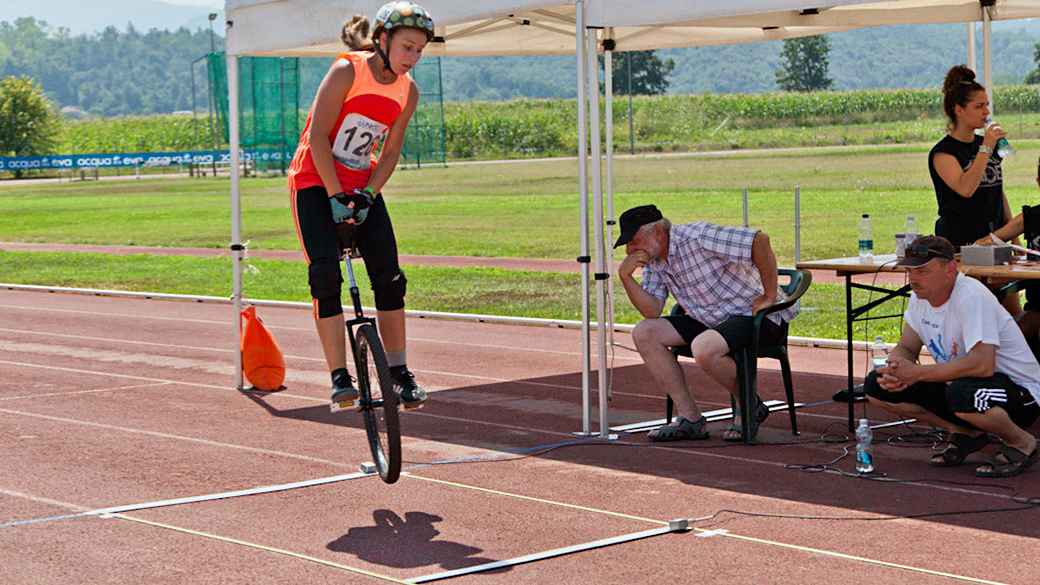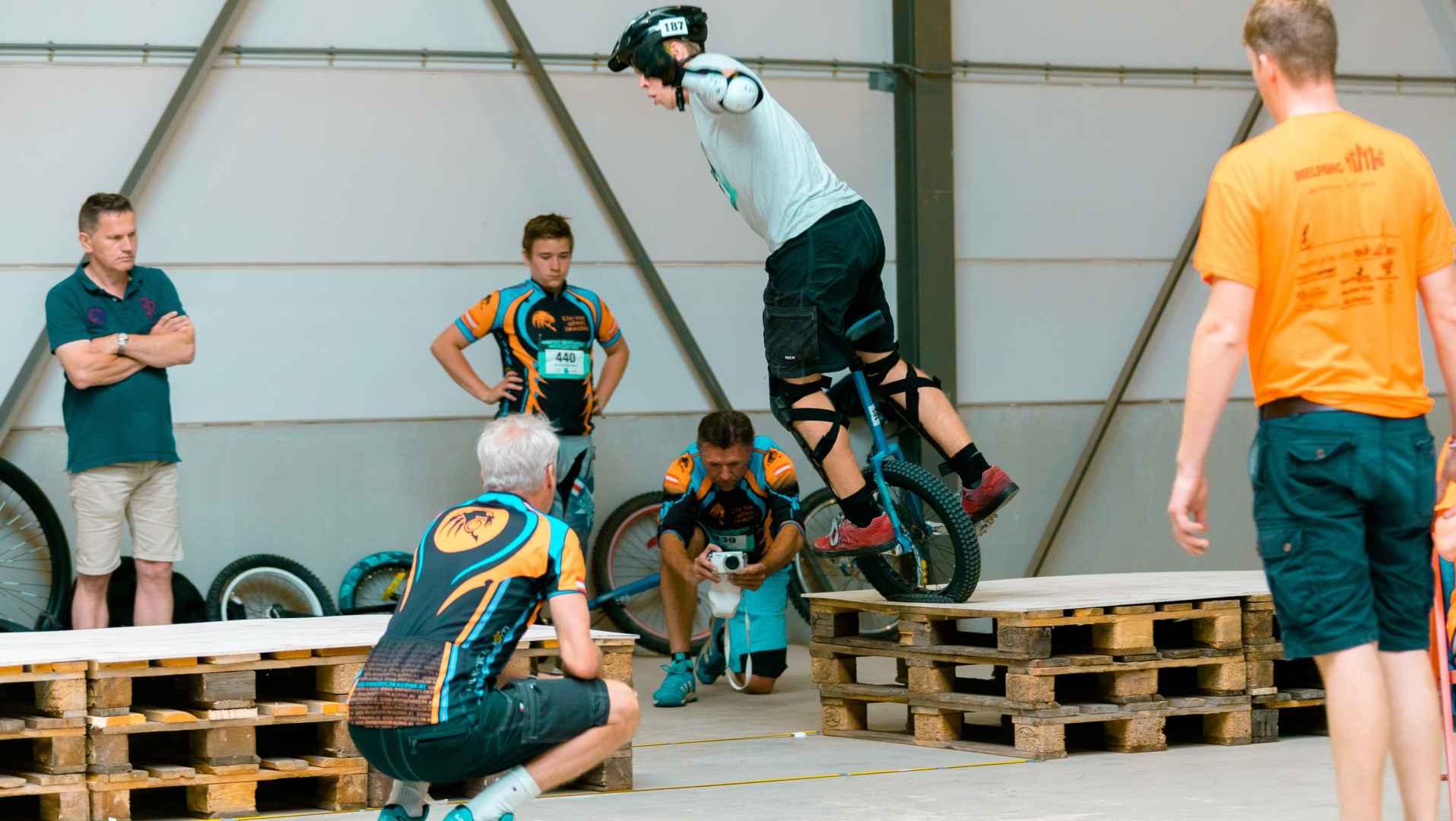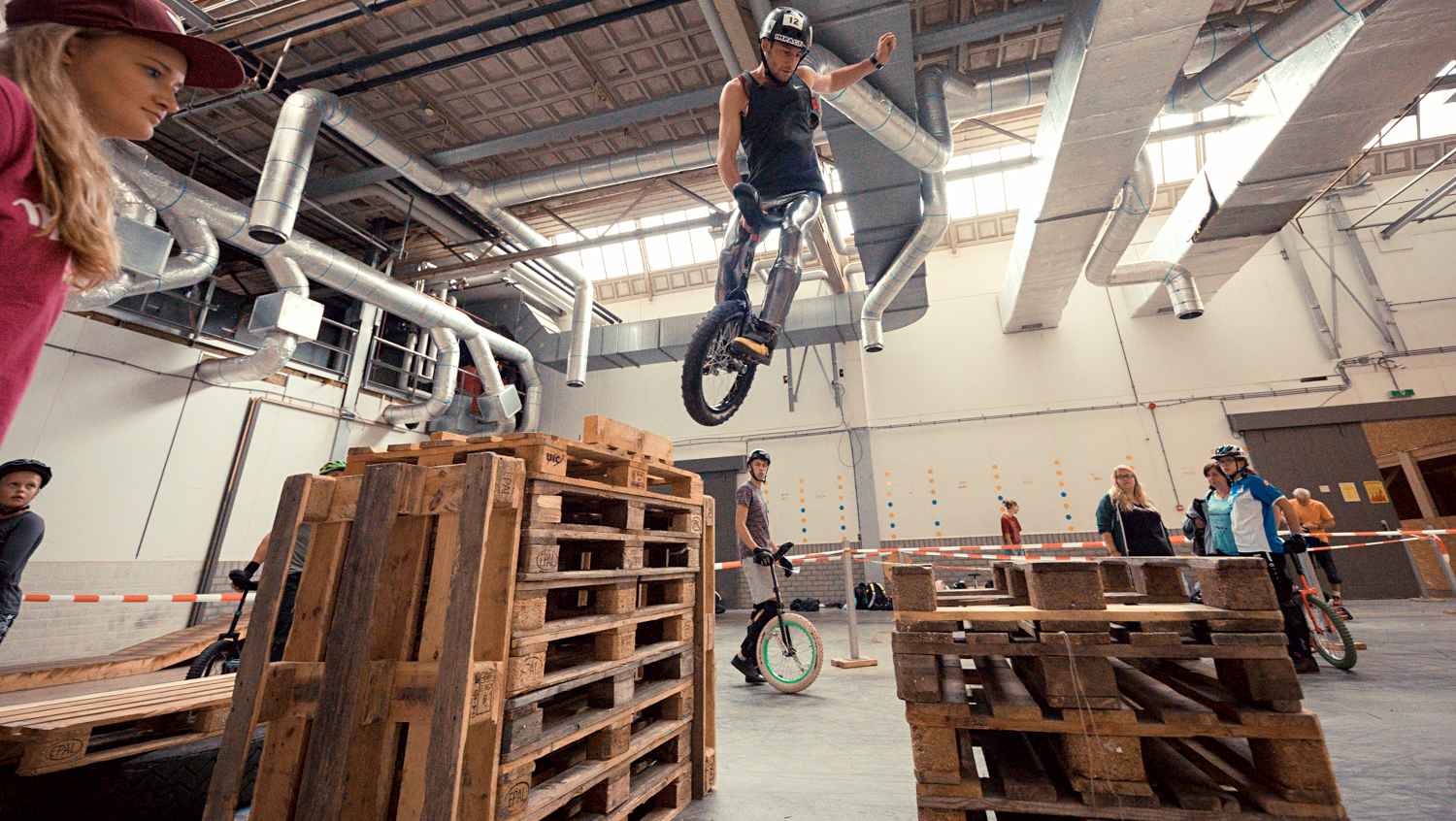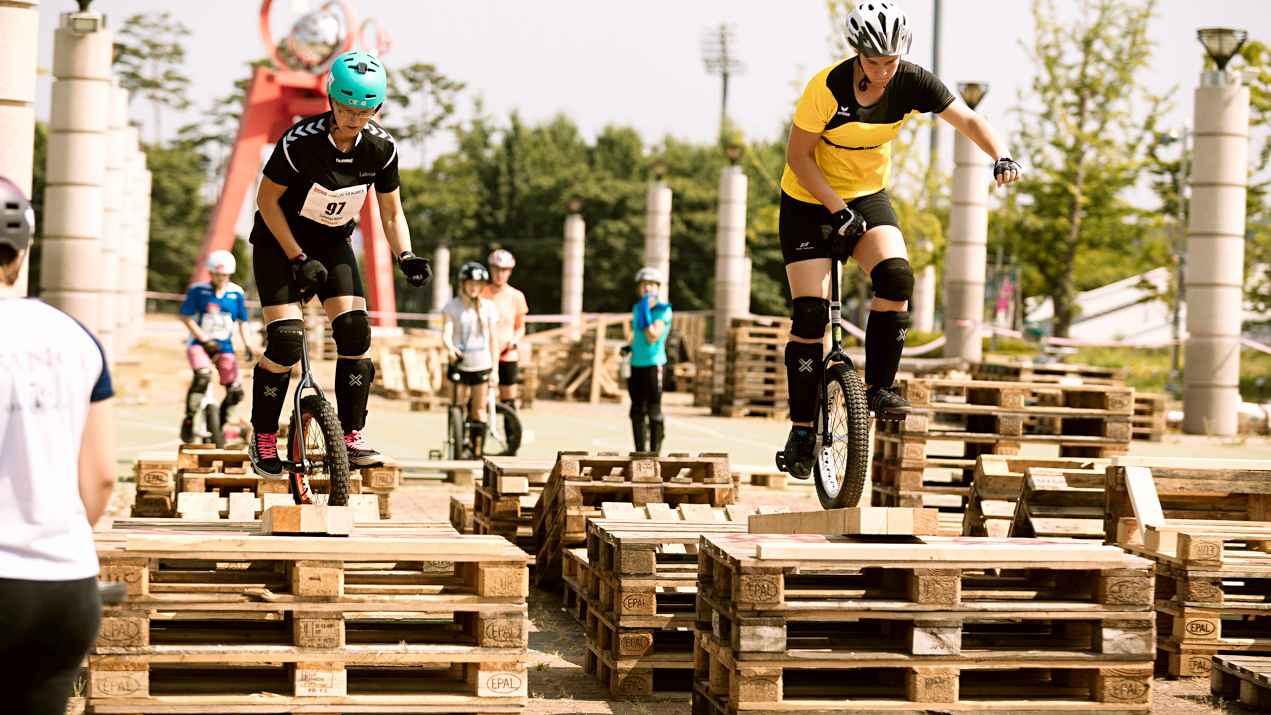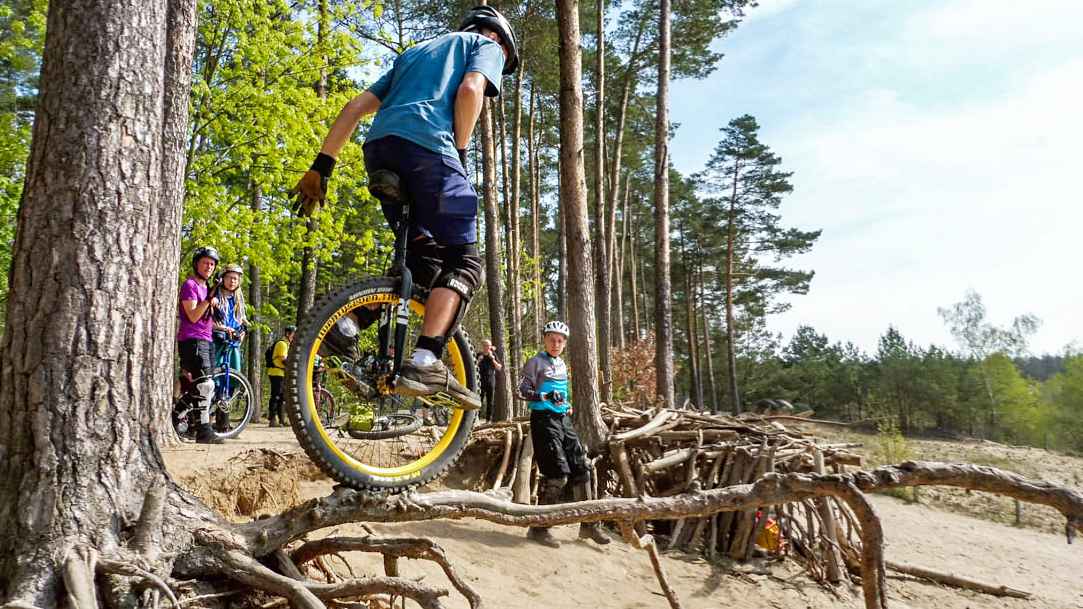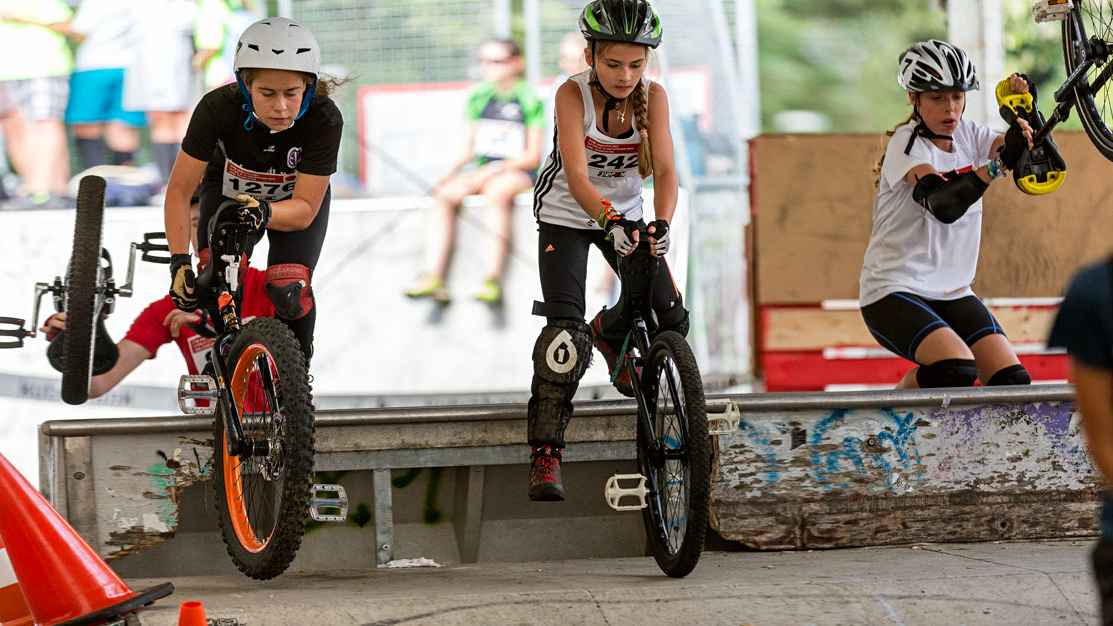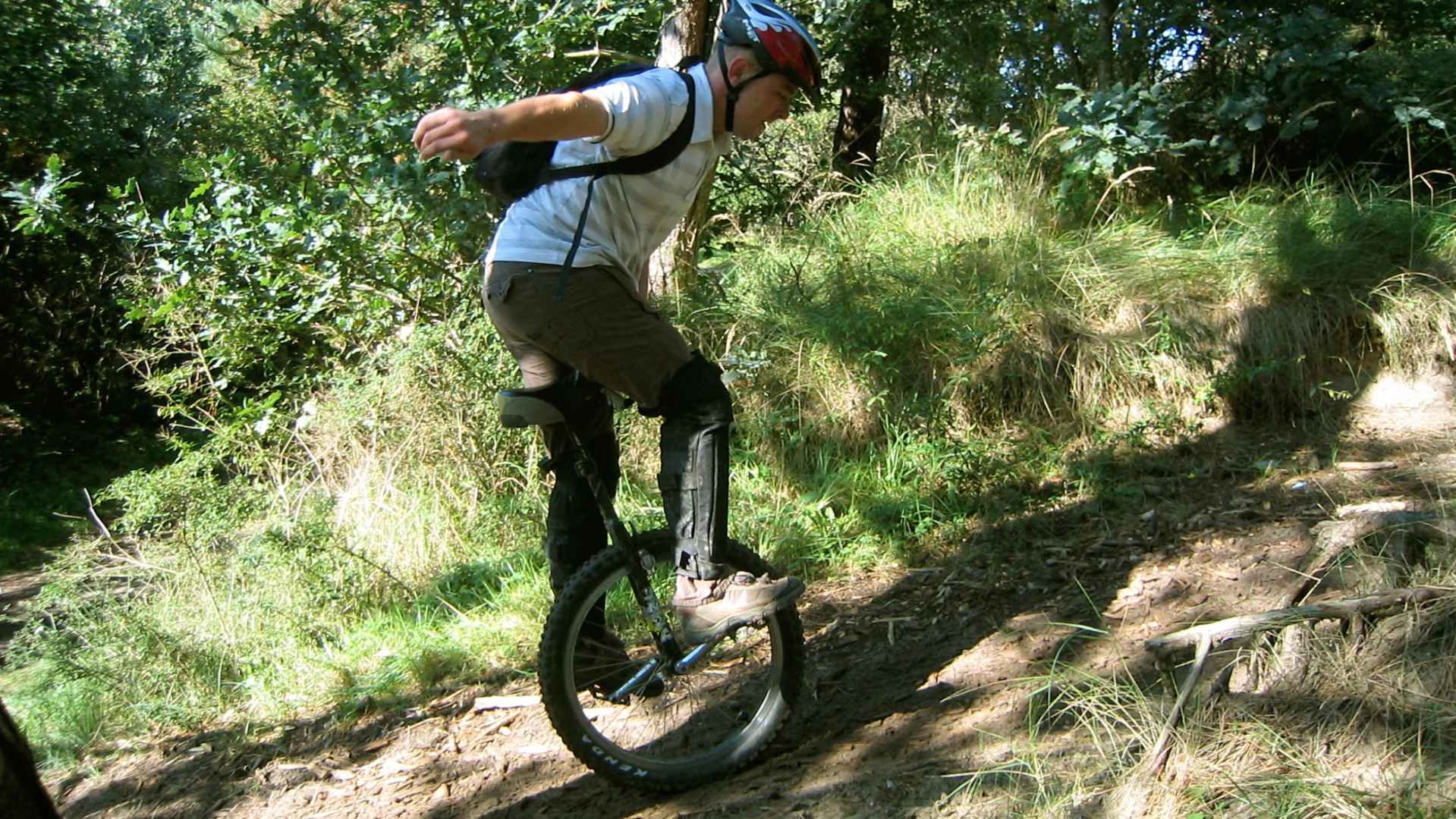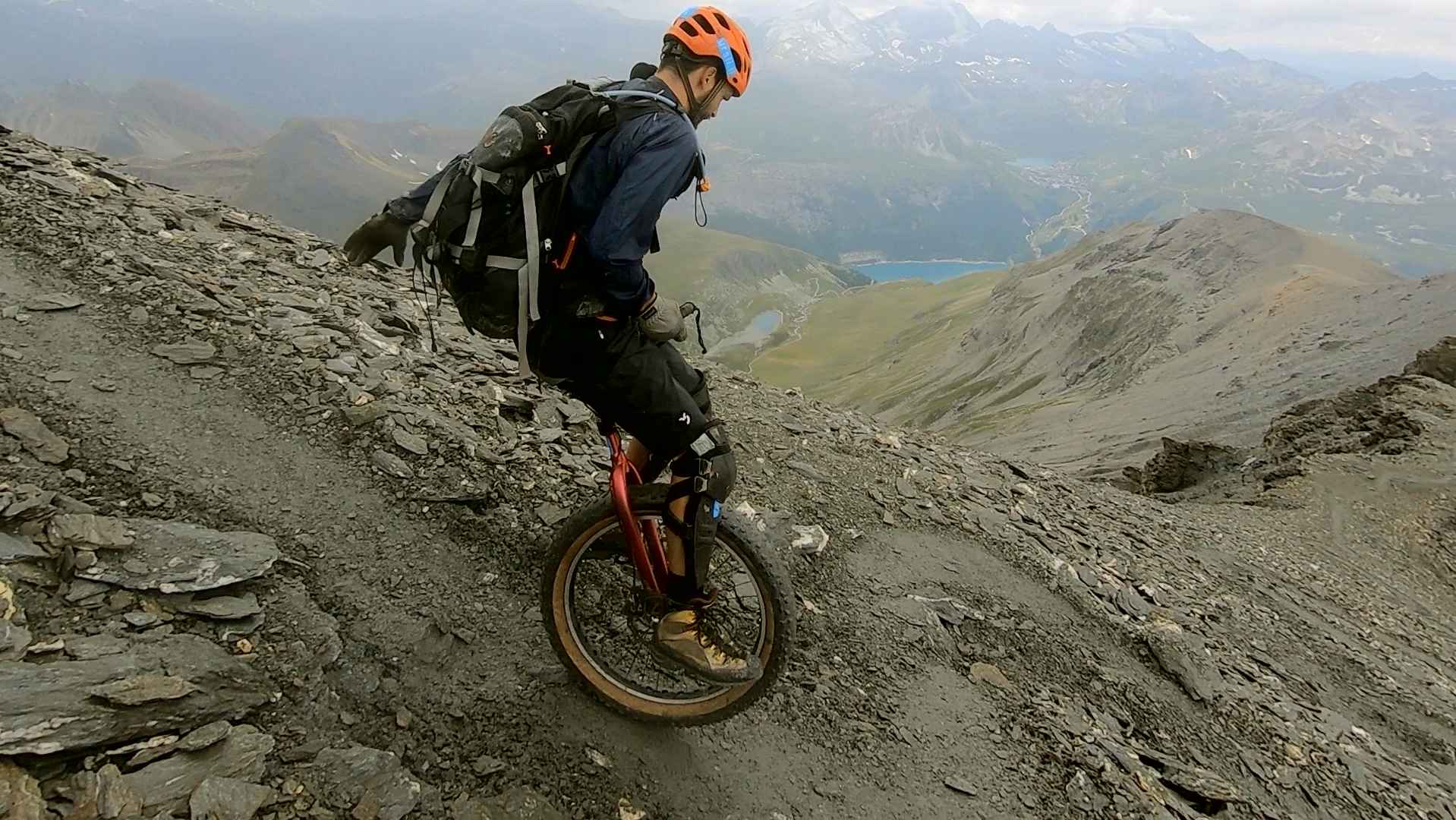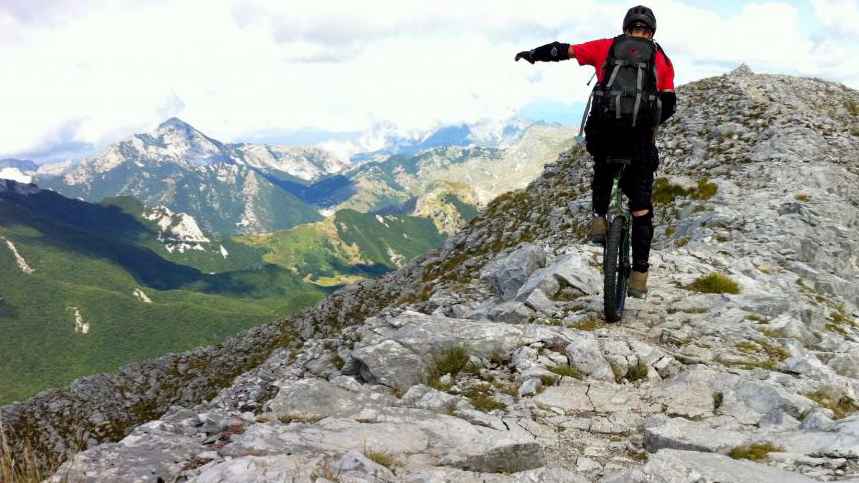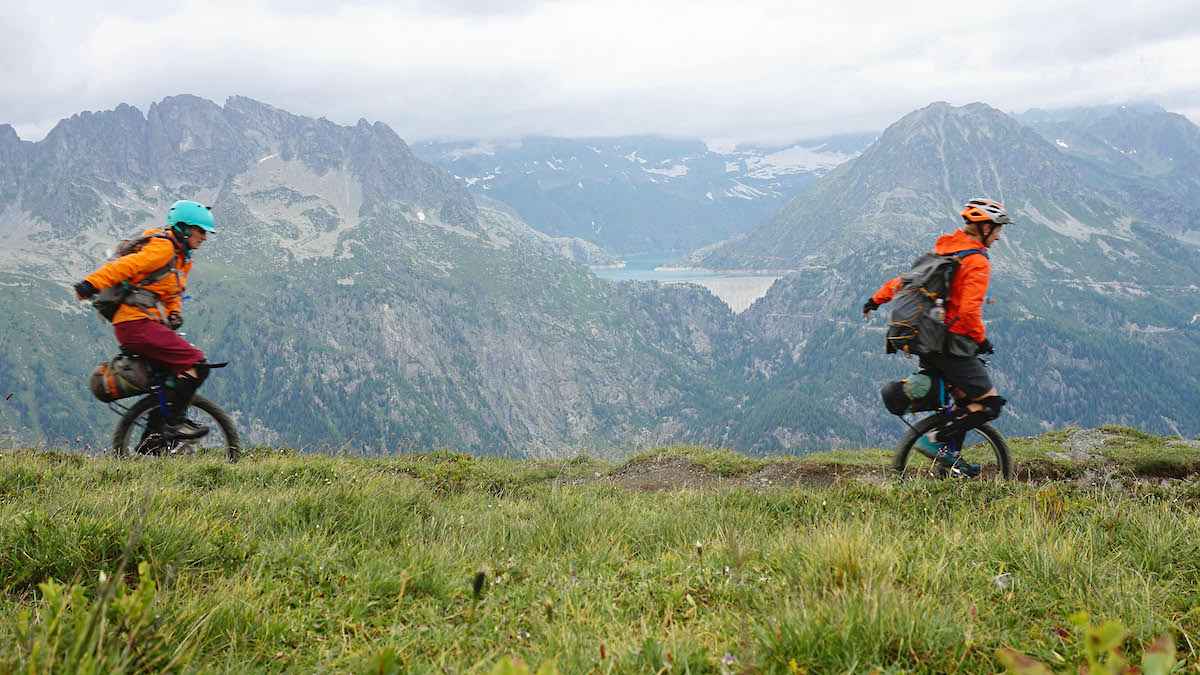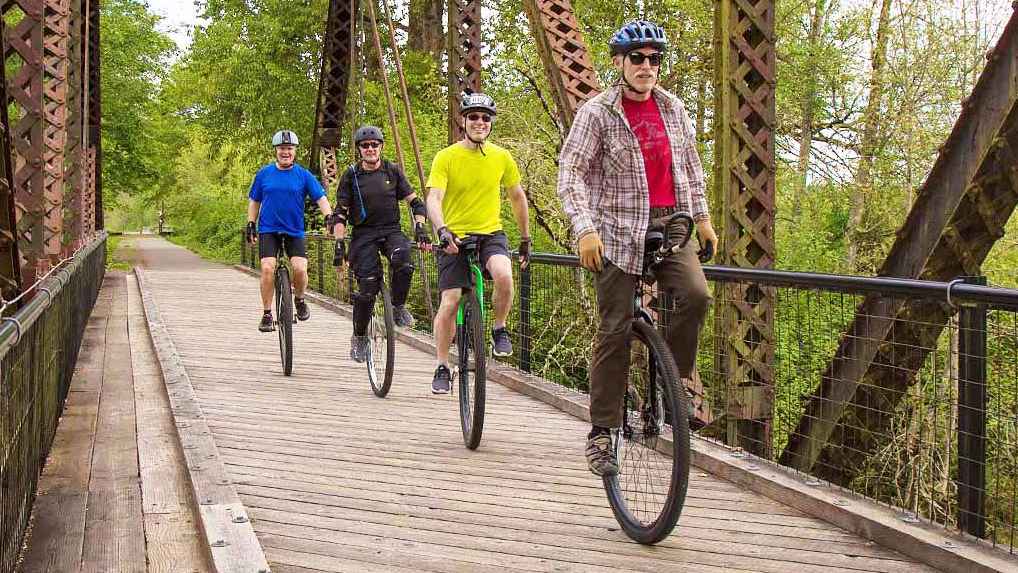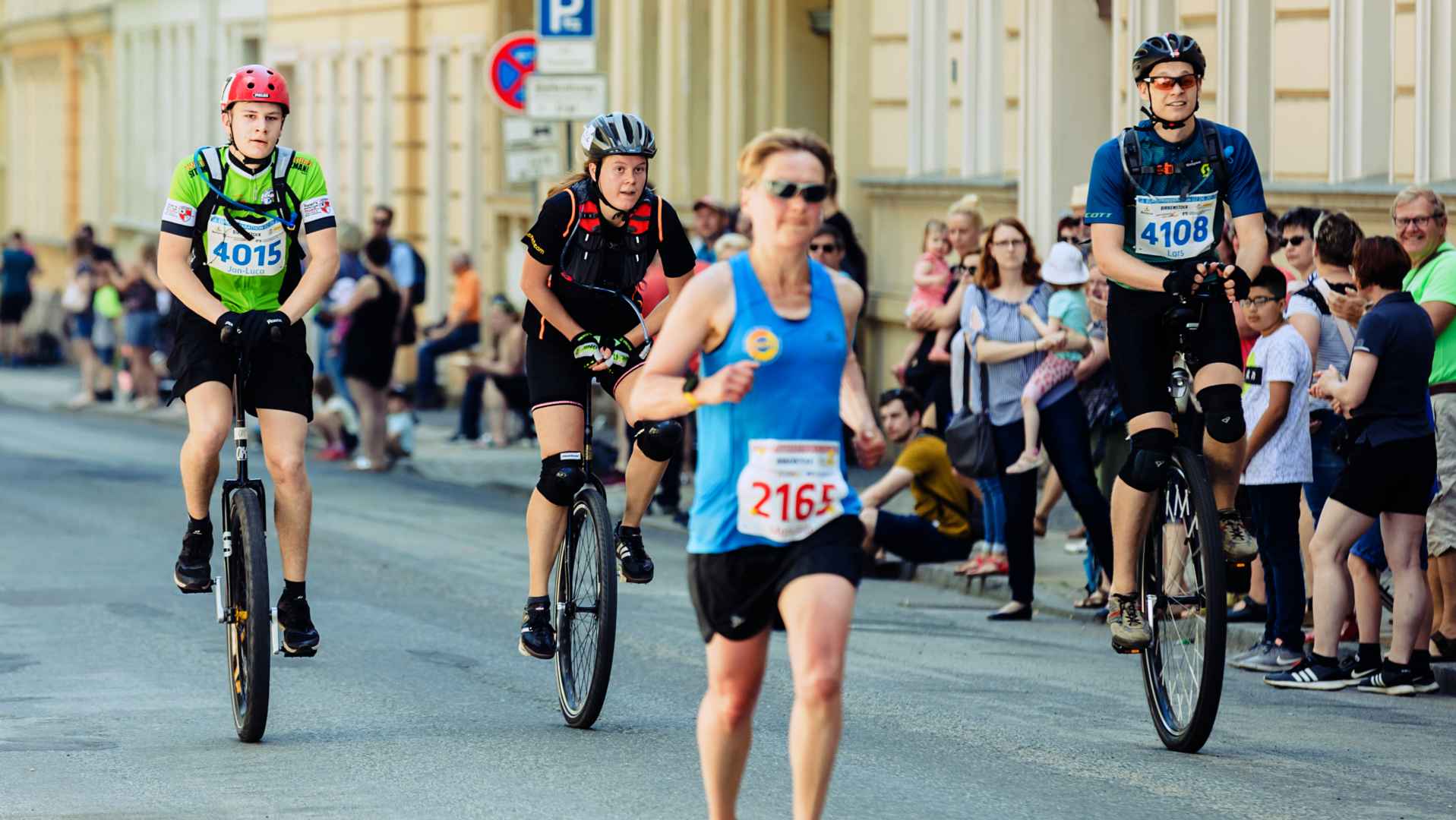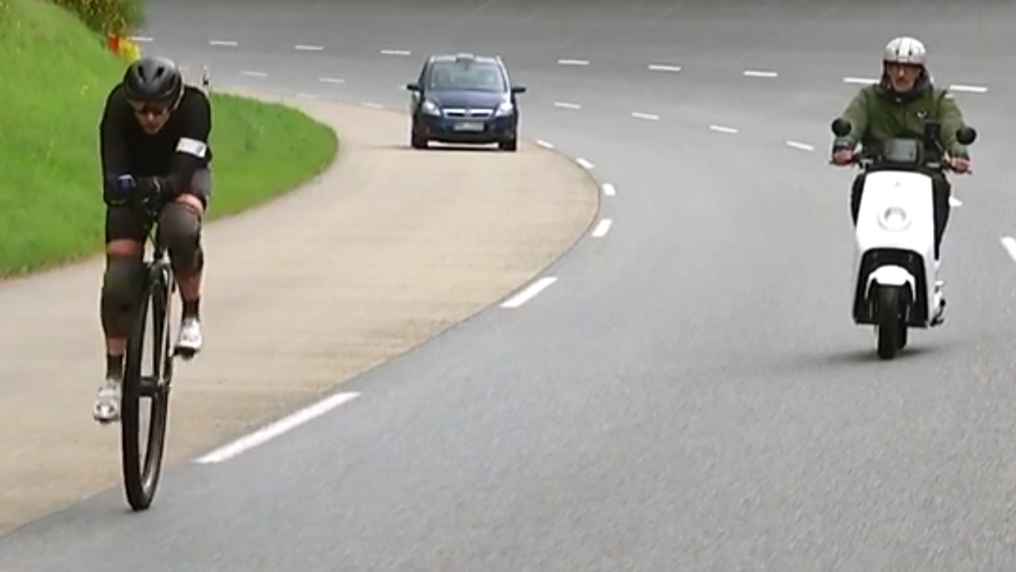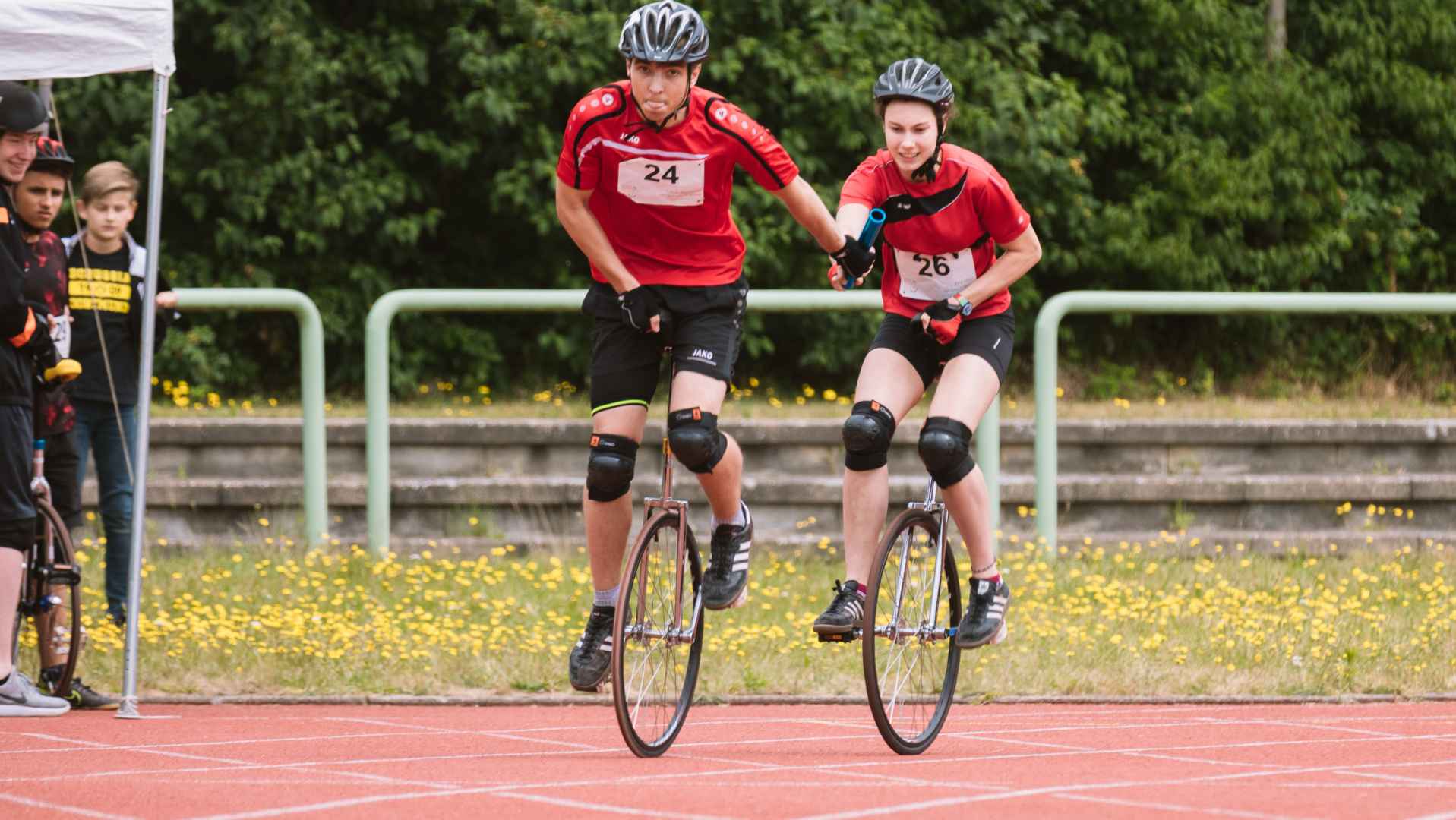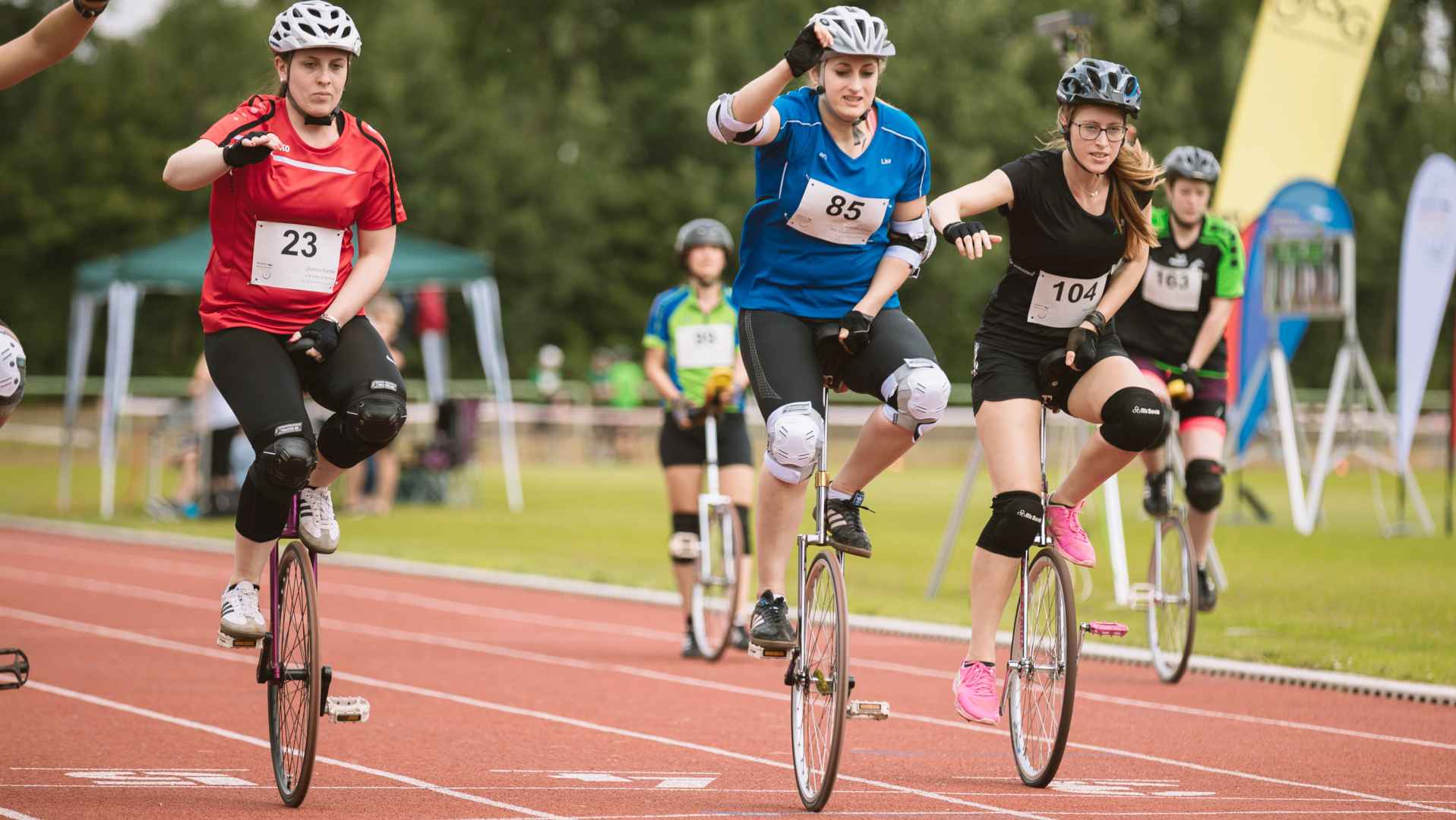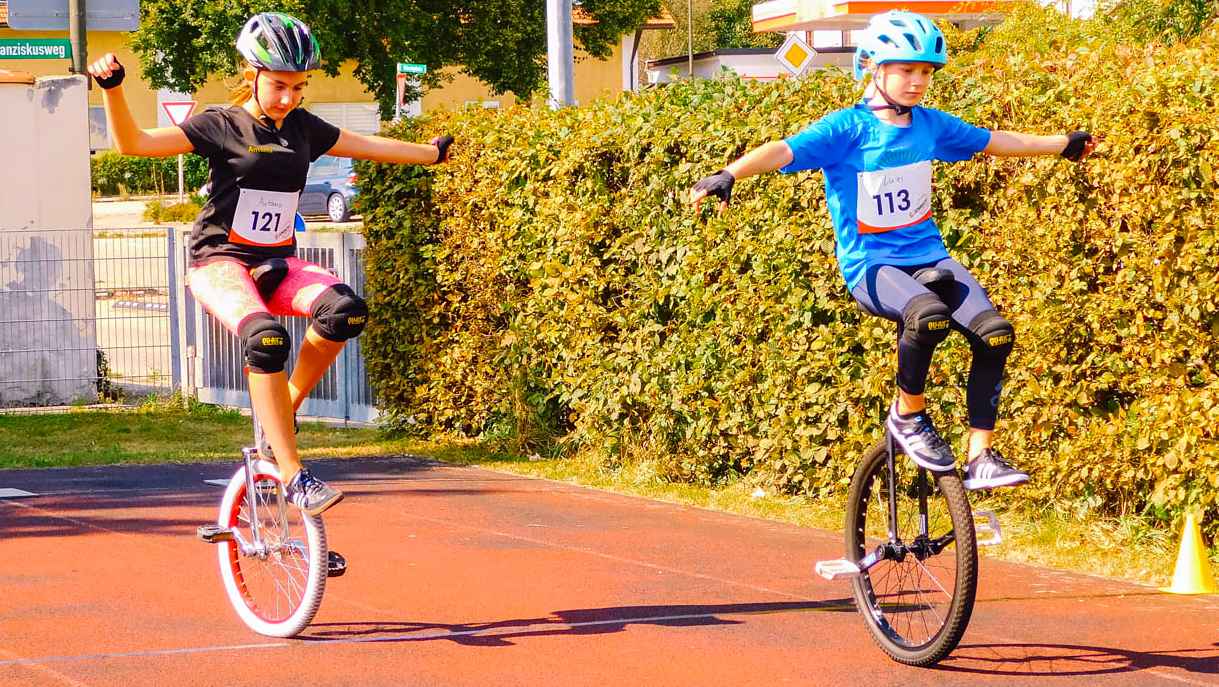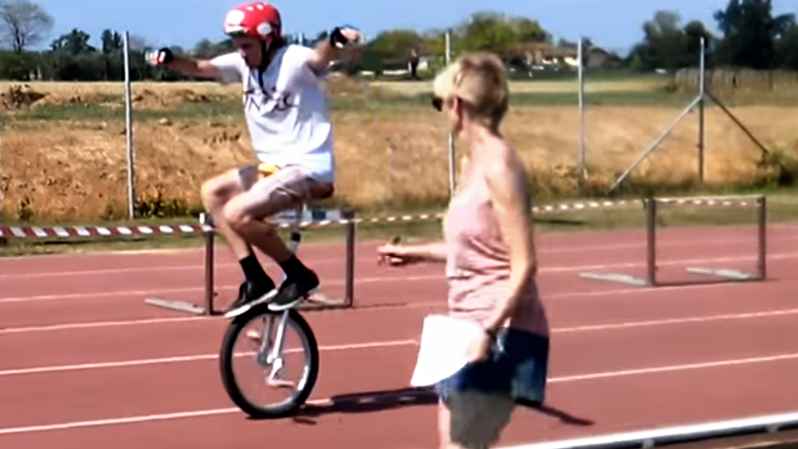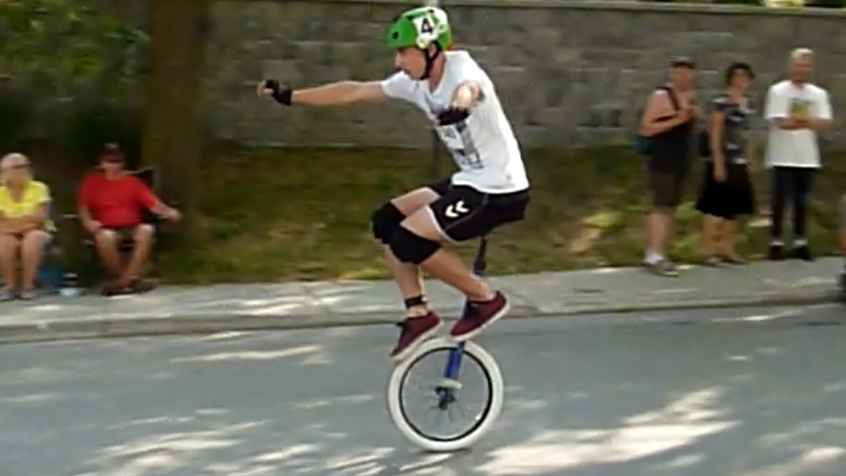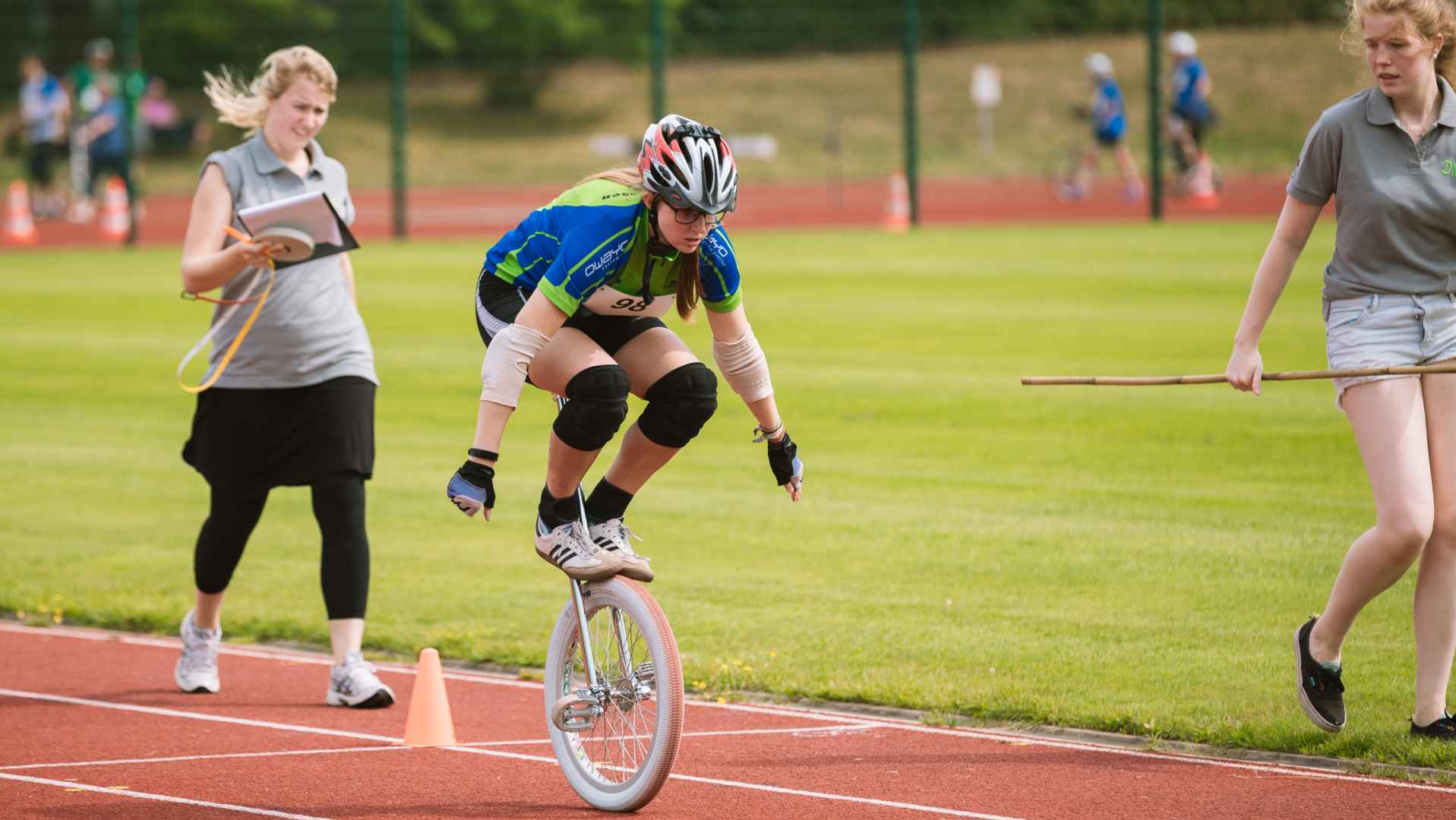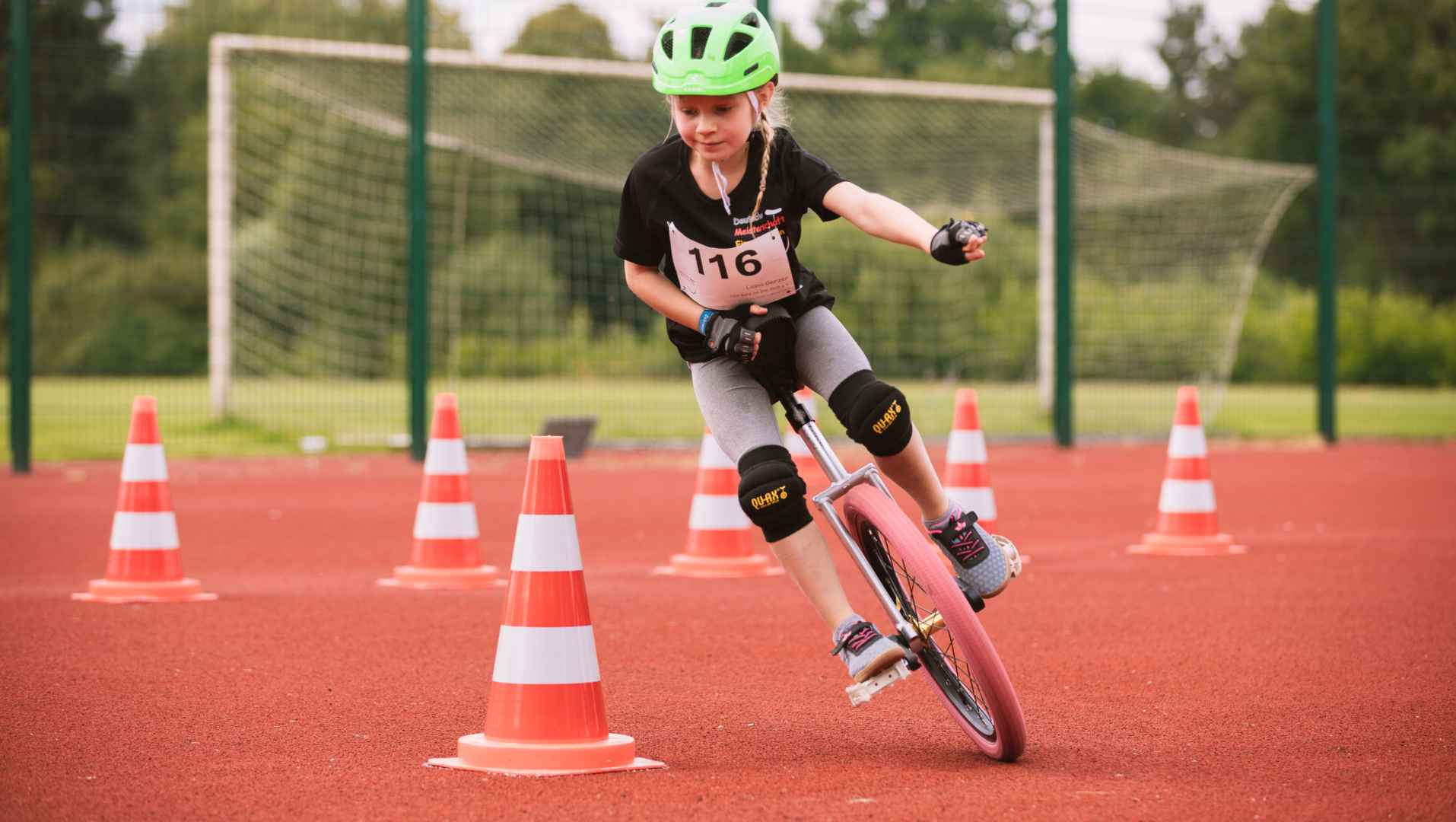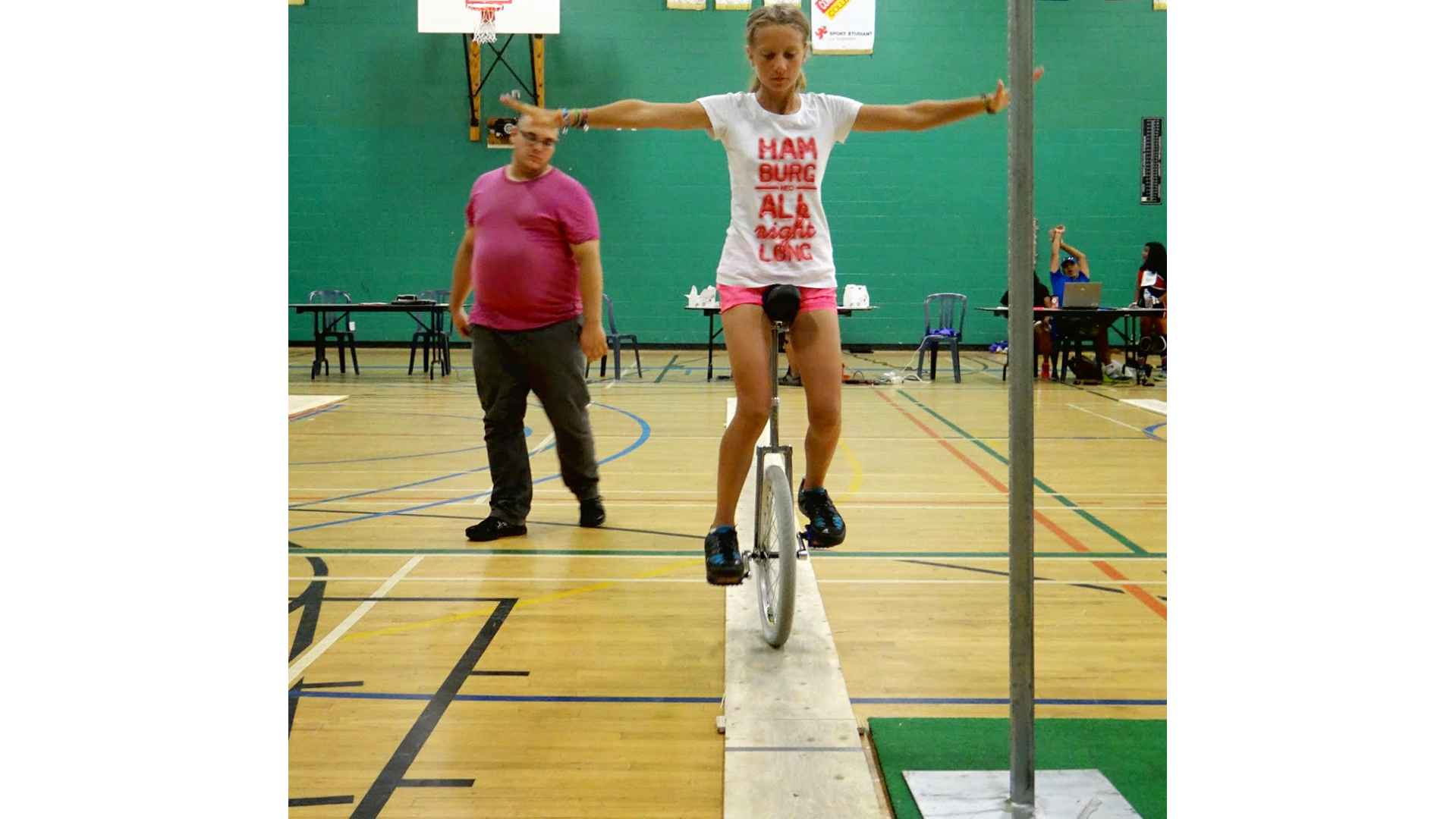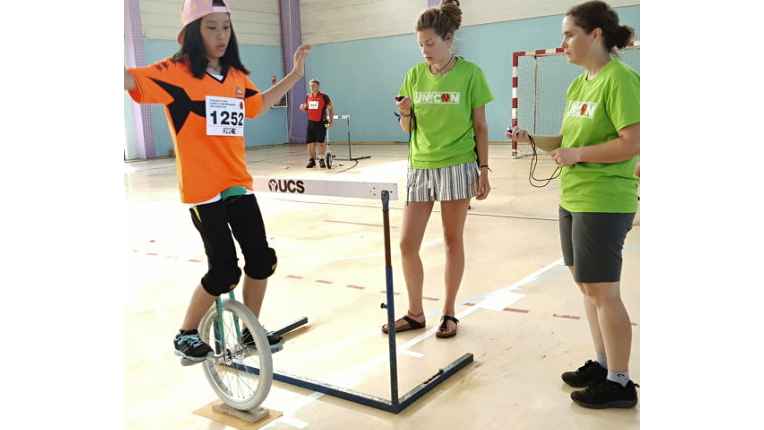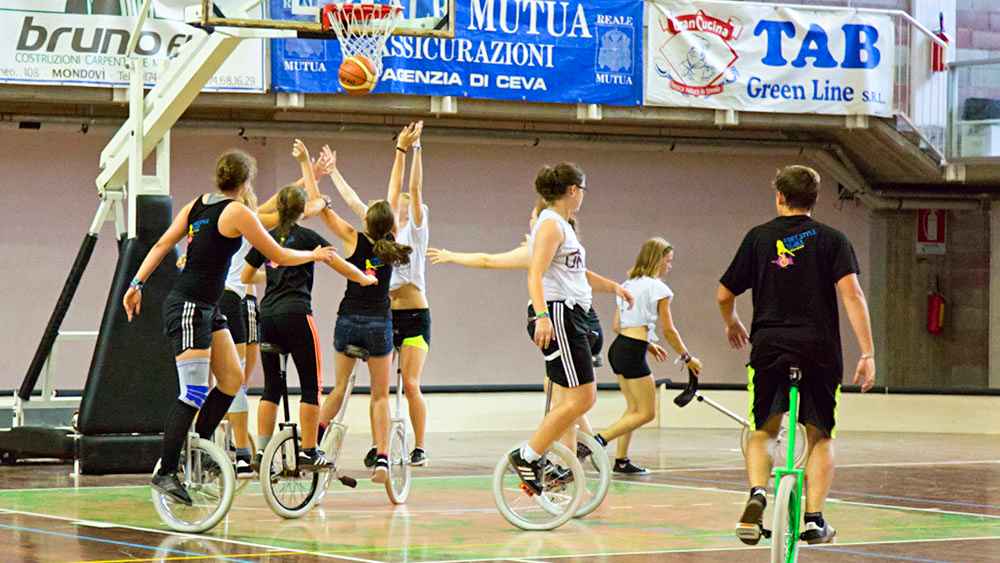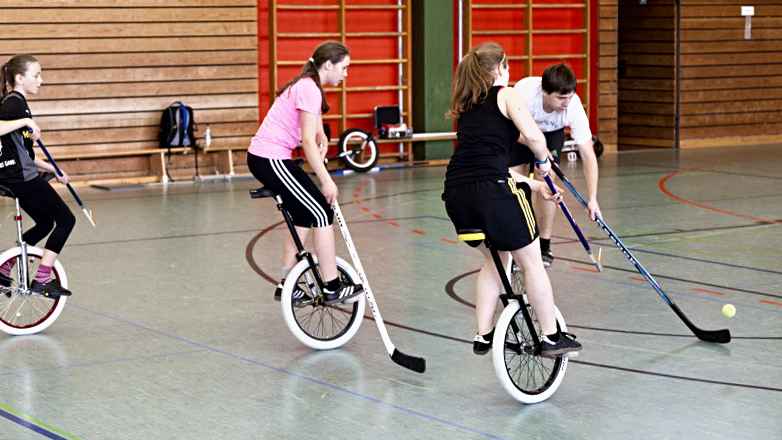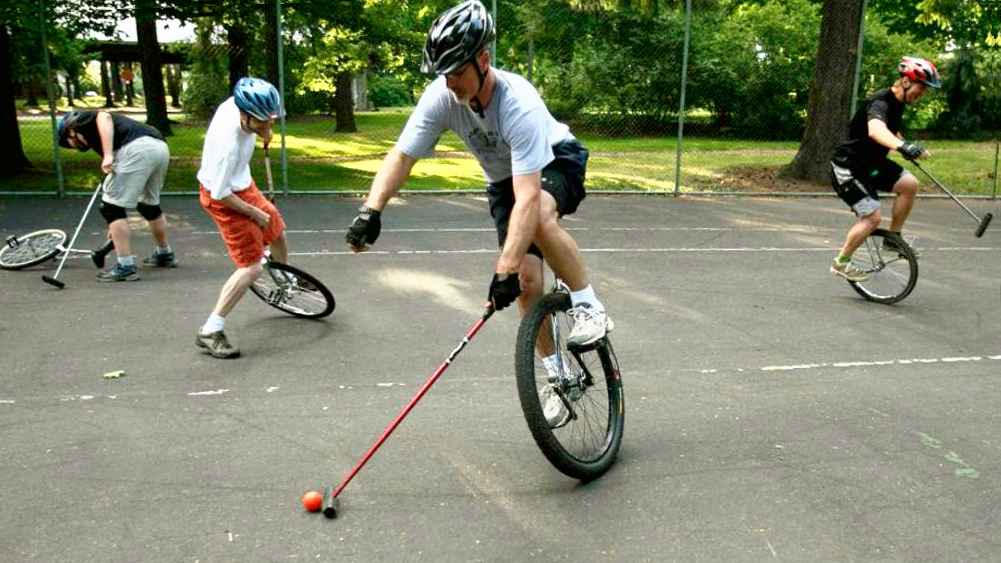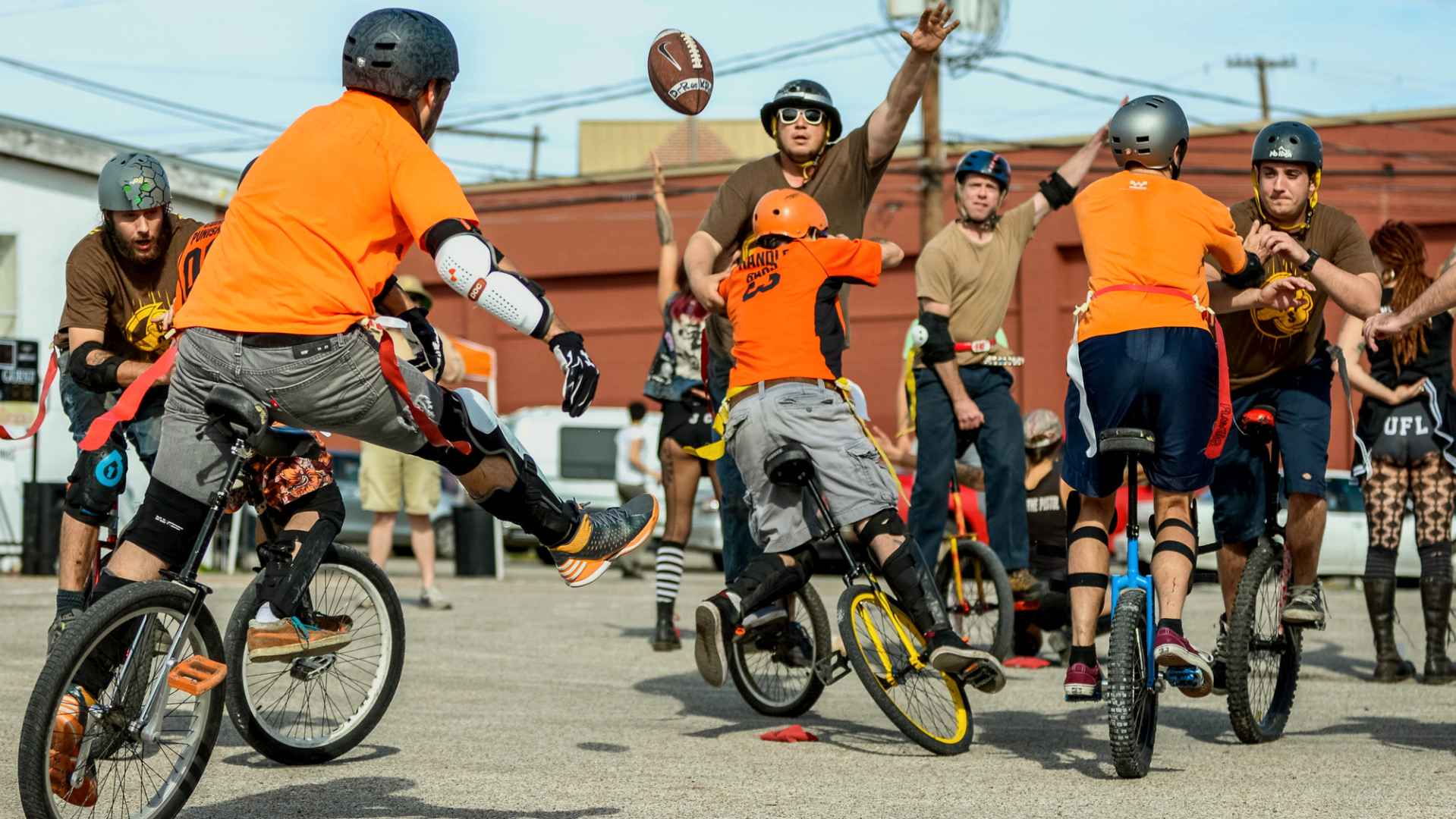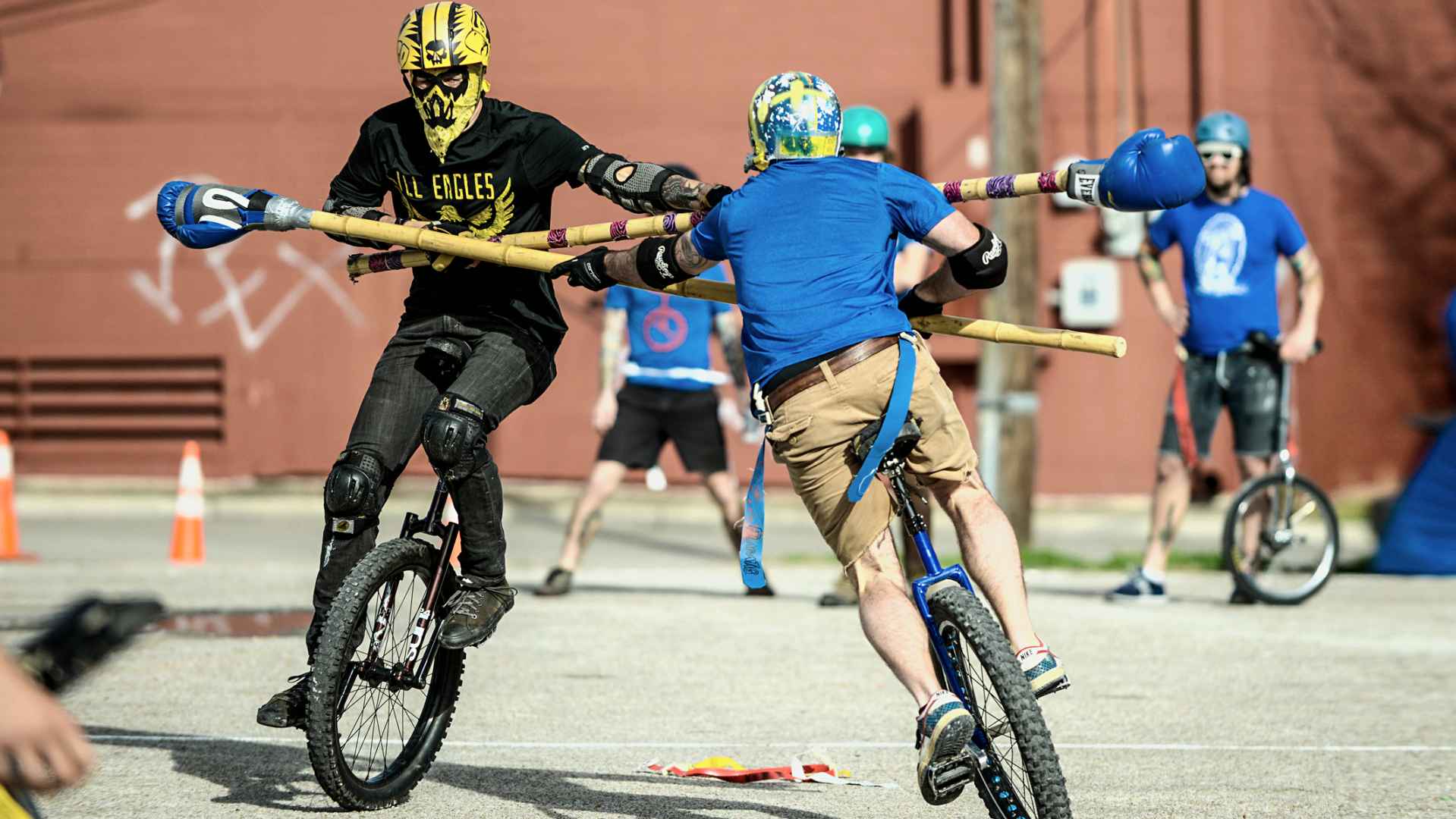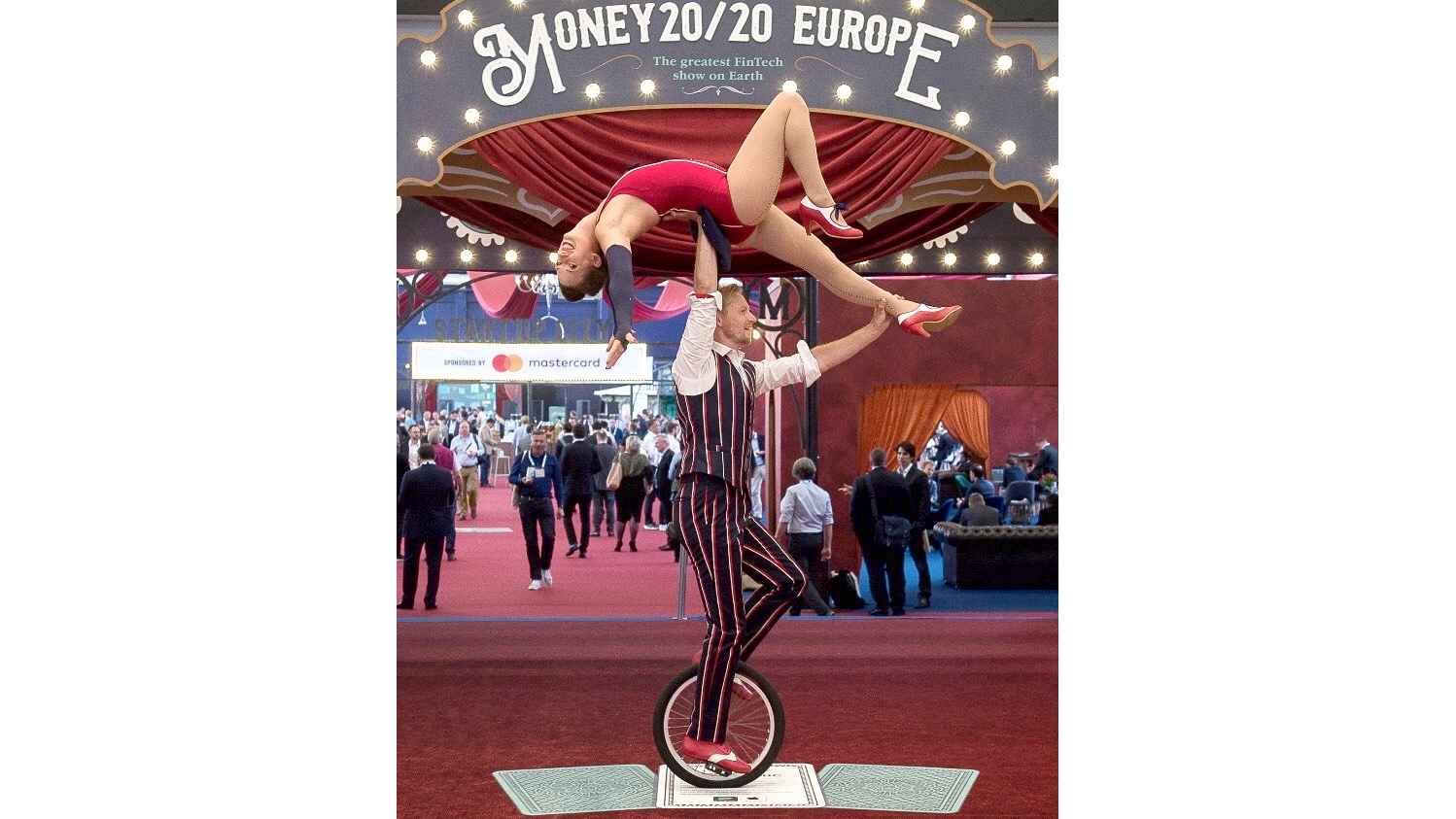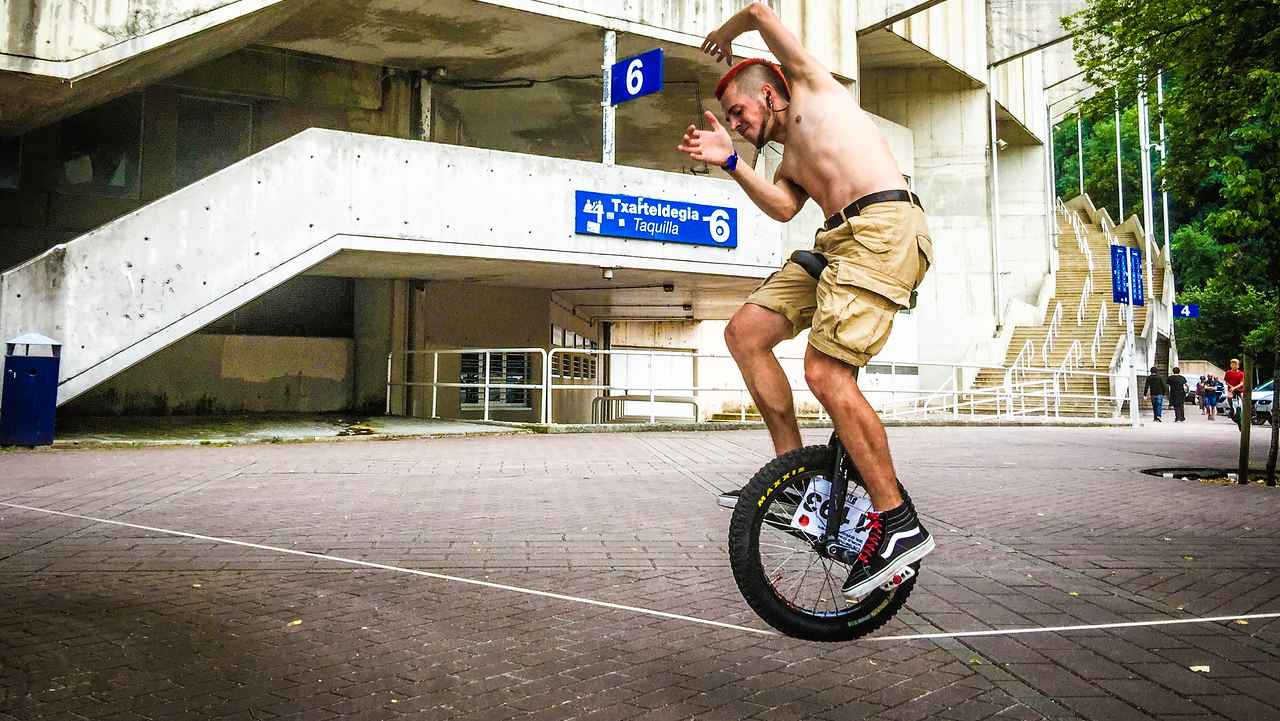On this page we present an overview of all important unicycling disciplines.
Disciplines are not to be confused with unicycling tricks or skills, rather they are the directions in which you can specialize.
In the family tree picture you can see how the various disciplines are related to each other. Generally, disciplines or even whole branches that are nearer to each other, are more closely related.
Clicking on any word in the family tree picture takes you to an explanation of that discipline, including photo and video examples.
The sport of unicycling is continuously developing. This page was last updated in 2021.
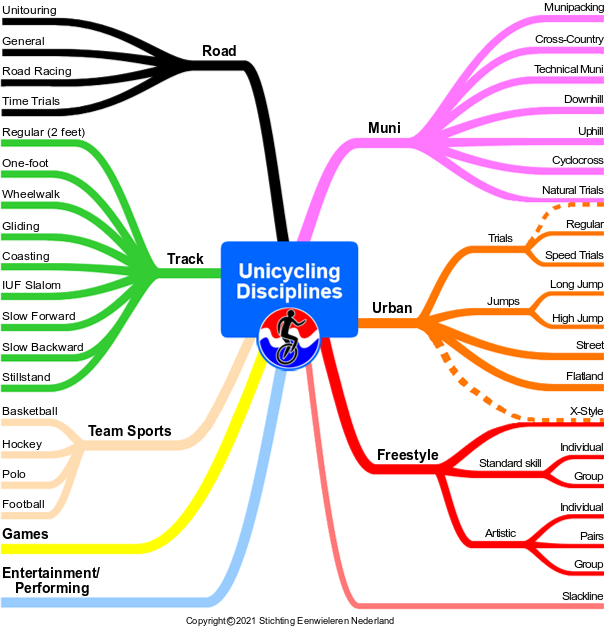
Freestyle
Freestyle is one of the oldest disciplines within unicycling, competitions were organised from the 1960’s, although the competition form and rules have changed a lot since then. The name Freestyle refers to the fact that one is free in choosing the elements and tricks to present.
In most cases when people just say Freestyle, they mean what is officially known as
Artistic Freestyle This resembles figure skating or show dancing. At first glance it doesn’t seem to be more than a series of tricks, but the point is to make smooth transitions between these, and present an aesthetically pleasing performance. Music is almost always used, and props (attributes) or set decorations are common. Often there is a theme, to which besides the choreography also the music, costumes and make-up subscribe. A panel of judges awards points for difficulty, execution, mistakes and many other details.
Artistic Freestyle, like figure skating, can be done by an individual rider (‘Individual’)…
… or by two riders (‘Pairs’)… … or by a group (‘Group‘) of riders, often split into ‘Small Group’ (3 to 8 riders) and ‘Large Group’ (9 or more). Back to topStandard Skill is a form of competition that involves correctly performing ‘figures’ (tricks/skills) on your unicycle. The ‘show element’ is irrelevant, but you do get more points if you do a figure properly (there are rules for correct form).
You specify in advance which figures you are going to do, from a long list of hundreds of allowed standard skills. Each figure on the list has been assigned a difficulty level, expressed in points. To give you an idea: the easiest is just riding, 1 point; the most difficult is ‘stand up coast figure 8’ (that is, ride a figure 8 with both feet on the frame), 9.5 points.
In a competition, you have three minutes to show all your chosen figures in the correct order. For each figure, you get a score based on its difficulty level and how well you execute it. Standard Skill is usually done individually, although there is also a form in which you show the figures as a group (four riders).
X-style is a relatively new form of competition (originated in 2013), where you show your most impressive tricks. All kinds of tricks are allowed. You will only be judged on the tricks that you nail. The ‘beauty’ of the execution, or falling, is disregarded. Judging is difficult because it often involves previously unknown (new) tricks, but this discipline is certainly spectacular to watch!
X-Style is officially (according to the IUF Rulebook) part of Freestyle, but also attracts many Urban (especially Flatland) riders. Hence the extra orange line in the “family tree” picture from Urban to X-Style.
The X in the name goes back to the Open-X discipline that no longer exists, from which Street and Flatland originated. Another clue that X-style is related to Urban.
Urban
Urban can literally be translated as ‘in the city’, but you shouldn’t confuse it with just unicycling in the city.
Urban is a collective name for a number of outdoor-based unicycling disciplines. More so than in the other disciplines, the Urban riders form a kind of subculture, which does not mix so much with the rest of unicycling. Urban has a cool image, similar to skateboarding.
Trials and Jumps are the oldest branches of Urban. Flatland and especially Street did not develop until about 2000. In the beginning only boys (and men) participated, but in recent years girls/women are on the rise.
Back to top
Flatland involves doing tricks on flat ground. It’s about doing impressive and difficult tricks such as unispins, rolls and crankflips, and about stringing them together in nice flowing combinations to form a ‘combo’. In Flatland’s competition format, you usually compete in ‘battles’ of two riders, where you take turns showing a ‘combo’ in front of a jury.
Back to top
Street is quite similar to Flatland, with the main difference being that you use stairs, edges, railings, benches and other three-dimensional objects. This is originally done in an urban (or at least built-up) environment and with the available ‘street furniture’. But quite often, a Street course is built for the purpose, for example in a sports hall.
It will be obvious: if you just ride in a street, this is not Street 🙂
Jumps is a collective term for High Jump and Long Jump. Each of those two can in turn be split into jumping onto something, or jumping over something (this is not shown in the family tree picture). So you have:
* High Jump Over Bar, this is similar to the high jump in athletics.
* High Jump Onto Platform, for example from the ground onto a pallet stack * Long Jump On Track, this is similar to the long jump in athletics, so jumping as far as possible from a take-off line.* Long Jump On Platform, usually from one pallet stack to another of the same height. An important difference with Long Jump On Track is that you have (almost) no run-up.In Jump competitions, you must remain on the unicycle for at least 3 seconds, or ride out of the landing zone after the jump, otherwise the jump will be invalid. This is different from athletics, where it doesn’t matter how the athlete lands. Most people who do Jumps also do Trials. And vice versa.Back to top
Trials is riding or jumping on and over (and sometimes through) all kinds of obstacles and objects. A Trials course is usually built up with pallets and wooden beams and planks, but it can also include other things, such as boulders and even cars.
The objective is to ‘navigate’ (overcome/conquer) a ‘line’ (specified route) in the correct way. The only thing that is allowed to touch the ground or objects is your tire, and with certain maneuvers also your pedals and cranks. It doesn’t necessarily have to look pretty, the important thing is that you finish the line from start to finish. A full Trials course can consist of ten or more lines. Riders can make multiple attempts at each line, limited only by the block of time allotted to riding the entire course.
A difference between Trials and Street is that with Trials you are only judged for conquering a line or not, while with Street it is mainly about the ‘flow’, and how pretty and skillful it looks.
To distinguish it from Speed Trials (see below) you can call the non-speed form of Trials “Regular Trials”. But usually this is just called Trials.
Speed Trials is a form of Trials, in which two equal lines are built next to each other. Two riders compete directly against each other to see who can complete the line the fastest.
Back to topMuni
The word Muni is an abbreviation of Mountain Unicycling. It is a collective name for all unicycle styles that are done off-road, such as on unpaved paths or across the terrain. You can compare it to mountain biking. Muni was ‘invented’ in the 1980’s, at that time it was called Rough Terrain Unicycling. The word Muni has been used from about 1995.
Back to top
Natural Trials (natuurlijke trials) has elements of both Trials and Muni. It’s Trials, but without having to build a course. Or viewed differently: it’s Muni where you ‘play’ in a challenging natural environment of boulders, fallen logs and the like.
Back to topCyclocross has been emerging as a form of competition since about 2013, comparable to cyclocross in (bi)cycling. This is usually done in multiple laps on a course of one or a few kilometers long, which also contains sections that are difficult or impossible to ride. Walking/running/jumping with the unicycle is part of the competition. In addition to sections of ‘natural’ off-road, there are often artificial elements in the route, such as straw bales, fences and the like. Obviously, which parts you can or cannot ride, depends on your experience and skill level.
While Cyclocross is a bit like Trials, this discipline has more in common with Muni because of the speed element, and attracts less Trials riders.
Uphill is climbing off-road with a unicycle. Usually the difficulty is mainly in the steep slope you ride up, and the surface is otherwise not very ‘technical’. The distance covered in uphill rides is often relatively short. Many off-road unicyclists don’t like Uphill, but for some this is their favorite part.
Riding uphill is of course also possible on paved roads, but this is not considered a separate discipline.
Back to topIn Downhill, the strenuous element of riding uphill is largely omitted. Usually a proper downhill route is in a mountainous area, and too difficult to ride up. Riders walk uphill with their unicycles, or take a cable car or other transport.
North Shore (not in the family tree picture) is a niche form of Downhill, where you ride on a specially prepared route with jumps, sloping ramps, tight corners and the like. These are usually quite intense, so this is really an advanced discipline! This style is named after the “North Shore” area near the Canadian city of Vancouver, where these types of routes were first created. North Shore is sometimes referred to as Freeride.
You could also consider Downhill and North Shore as subcategories of Technical Muni.
Technical Muni is for some the ‘real’ Muni. With Technical Muni, the terrain is typically more difficult than with Cross-Country. The joy of Technical Muni lies in successfully navigating difficult passages – covering distance is less important. A recurring element is having to jump or ‘drop’ (jump down).
Back to topCross-Country refers to all off-road unicycling that is not so “technical” or difficult. There is not much jumping involved, (almost) everything can be rolled. Cross-Country often involves longer distances, for example 10 km or more.
Back to topMunipacking is composed of the words Muni and backpacking. This is riding a multi-day offroad unicycle ride. You can think of it as the off-road variant of Unitouring. See also Unitouring.
Finally: “Extreme Unicycling” (not in the family tree picture) is a collective name for the most spectacular disciplines within Urban and Muni, such as Street, Trials and Downhill. Because there is more specialization these days, this collective name is no longer used very often, but you can come across it in older videos.
Back to top
Road
Road unicycling is riding on usually sealed roads and (bicycle) paths, where the main goal is covering a (short or long) distance. Road and Muni cannot be strictly separated: there is a gray area associated with riding on semi-paved or very easily rideable roads and paths.
Back to top
Unitouring (also called Unicycle Touring or Unicycle Tours) is riding a multi-day trip by unicycle, where you ride on roads, cycle paths and other easily rideable routes. This often involves considerable distances per day, from 20 km to more than 100 km.
Both Unitouring and Munipacking can be ‘supported’ or ‘unsupported’.
With Unsupported you have everything you need with you. Think of your sleeping gear, clean clothes, etc. Or you buy it on the road, such as food. In Munipacking you’re usually (wild) camping, so you might need a tent and sleeping bag (or a bivvy bag and/or hammock), cooking equipment etc.
Supported means that you only have your day luggage with you during the day. Your remaining luggage will be transported to the next stage every day. During the day there can also be support in the form of meals, a sag wagon and the like.
Both forms of multi-day tours can be done on your own or with several riders.
Not everyone agrees on the names Munipacking and Unitouring, although these are the most common names. The word Unipacking is also used, but not everyone means the same by it.
Back to top
General road riding is not really used as a name for a unicycle discipline. By this we mean all Road unicycling that does not fall into one of the other categories. It could be a sightseeing ride, or riding in the street with friends for fun. If you unicycle to school or work, or run errands, this would also be General road riding.
Back to topRoad Racing are unicycle races on public roads, where those roads may or may not be closed to other traffic. Common distances for road racing are 10km and marathon (42.195km). Since 2012, 100 km has also been held occasionally as a Road Racing race, as a solo race or relay race. Road Racing on unicycles is quite similar to road racing on bicycles.
In Road Racing competition, there is often a choice between ‘unlimited’ where any type of unicycle is allowed, and ‘standard’ where restrictions apply to wheel size, gearing and sometimes crank length.
Time Trials is a form of racing where you ride strictly on your own, without interference with other riders (such as tailgating one another to stay out of the wind). Usually there is only one rider at a time, for example during record attempts, but several riders can participate in the same event if they start at intervals (e.g., one minute). Time trials in bicycling follow basically the same rules.
Note: despite the similar name, this discipline has nothing to do with the Trials discipline that falls under Urban!
There are two types of Time Trials: The distance can be fixed (e.g. 100 km) and the aim is to ride that distance as fast as possible. Or the time is fixed (e.g. one hour), where the aim is to ride as far as possible in the set time.
Back to topTrack
Track is an extensive category of competitive disciplines traditionally performed on or around an athletics track. You can of course also do Track outside of competition, but then you are probably training with the ultimate goal of competing.
Track, or Track Racing in full, is one of the oldest discipline in unicycling. Competitions were already held in the 1970s. In most Track Racing disciplines, the wheel size must not exceed 618 mm (approximately 24 inches); often this is referred to as ‘standard class’.
* Regular (2 feet) is not actually used as a name. We use it here as a collective term for all types of Track Racing where you race a certain distance with both feet on the pedals. Common distances are 100m, 400m and 800m, and 4x100m relay.
* One-foot is a race with only one foot on the pedal, the other foot is put on the frame or (rarely) ‘floats’ in the air. One-foot competitions are traditionally done over a distance of 50m.* In Wheelwalk you don’t have your feet on the pedals, but you “walk” with your feet on the tire. This too is only done over short distances. Sometimes you still see the older name “Walk The Wheel”.* Gliding is riding the unicycle without feet on the pedals, where you control your speed and balance by pressing your foot on the tire as a brake. If this is being done as a track race, you first gain speed with two feet on the pedals. From a certain line you have to be gliding, the goal is to get as far as possible.There is also such a thing as Downhill Gliding (not in the family tree picture). If you are good at this (and daring enough), you can go faster with this than with regular pedaling. Sometimes you come across the older name High Speed Gliding.Back to top* Coasting is similar to Gliding, but your feet may not touch the tire or the pedals. You maintain balance with your arms and your upper body, in combination with at least one foot on the frame. Track Coasting follows similar rules as for Gliding.
(Obviously, coasting can be done outside athletics tracks, e.g. on roads or gym floors, but then it mainly qualifies as a skill. Road Coasting is sometimes considered a niche discipline though.)
There are also unicycles with a freewheel hub, these are called freewheel(ing) unicycles, or sometimes (confusingly) coasting unicycles. With these, you can keep the pedals still while you continue rolling, just like with most bicycles. Freewheel unicycles are quite difficult to ride. And they are not allowed in regular Track races, only in unlimited races.* IUF Slalom is a set course around ten traffic cones in a specific pattern, that you have to ride as fast as possible. There are straights, but also circles and zigzags. This discipline comes down to agility, and for the better riders also the art of hard acceleration and braking.* Slow Forward is a competition to ride as slowly as possible, traditionally over a distance of ten meters. One of the requirements is that you have to keep moving forward all the time. Most beginners approach this as normal riding, but as slowly as possible. For advanced riders it feels more like a variant of stillstand, while at the same time you ride slowly but surely forward.* Slow Backward is the same as Slow Forward, but while riding backwards.* Stillstand is what the word says: stand still on your unicycle. You mainly keep your balance by swinging your arms and upper body. Very small foot movements are allowed, because your wheel is on a small board and must remain on it, but of course you are not allowed to idle.
Slow Forward, Slow Backward and Stillstand are collectively known as the Balance disciplines, because you have to be able to keep your balance without correcting with your wheel.Back to top
Team Sports
Team Sports are sports on the unicycle that you do as a team. All team sports on the unicycle, and the rules associated with it, are derived from regular team sports (on foot).
Back to top
Basketball (basketbal) and Hockey are the best known team sports on the unicycle. These two are often played as a competition in major unicycle championships.
Countries where Basketball is popular include the United States (Puerto Rico!) and France.
Countries where Hockey is popular include Germany and Switzerland.
Unicycle Polo is similar to Unicycle Hockey, but the rules are derived from regular polo.
Back to topUnicycle Football is similar to rugby or American Football, rather than soccer.
Polo and Football are relatively unknown unicycle team sports, but there are official competitions and rules for them.
Back to top
Games
Games includes all interactive fun activities on unicycles that are more informal than Team Sports. For example, there are no internationally recognized rules for them, or they are never done as an official competition. The number of games is endless. Many games have counterparts in the non-unicycle world. Some of the more famous games are “Sumo” and “Gladiators” (fight, whoever hits the ground is out).
There is also such a thing as dancing on unicycles, which you could also consider as a unicycle game.
Entertainment/Performing
Entertainment/Performing is anything you do for the main purpose of entertaining an audience. This includes, for example, in a (youth) circus, in a theater or on an ‘open stage’, or a street performance, including riding in a parade or procession. Unicycling is often combined with other things such as juggling or acrobatics.
Entertainment/Performing is probably the oldest known form of unicycling, with a history dating back at least to the 1880s. As a result, the general public still mainly associates unicycling with circus.
Unicycling activities such as Track and Road Racing, Trials or Team Sports, while often attracting crowds, are not Entertainment/Performing as the main purpose is not to entertain the crowd, but to win the race/match, or practice your unicycling.
Most unicyclists who engage in Entertainment/Performing are amateurs. But there are also people who ride unicycles professionally. Professional unicycling is almost always in the department of Entertainment/Performing. There is simply not enough money to be made with other unicycling activities.
Back to topSlackline
Slackline is unicycling on a tensioned wire or webbing (ribbon). Strictly speaking, Slackline only refers to unicycles on a slack-tensioned narrow ribbon. There are some variants such as highline, where you ride high above the ground, and tightwire where you ride on a cable that is tensioned very tightly.
Slackline (in combination with unicycling) has relatively few practitioners, if only because it is quite difficult. You may encounter it most in the circus, but then it falls under Entertainment/Performing.
In recent years, Slackline (with its variants) has been slowly emerging as a branch of unicycling worldwide. Just enough to include in this overview. 🙂
Photos are from the following sources:
Konstantin Höhne https://konstantinhoehne.de/
Markus Büchel
Klaas Bil
An’So Rodet http://annesophierodet.com/
Walter Herzog
Chris Huriwai
Jörg Boder
John Foss
Jim Thode
Mirjam Lips
UniCirque http://www.tobitandjasmijn.com
Tom LaValley
Unicycle Football http://www.unicyclefootball.com
Jana Tenambergen
Mittelbayerische (krant)
Dmitry Bibichkov
Unicon 19 (organisatie)
X Games http://www.xgames.com
We have requested all sources for permission to use their material, none of them denied.
Nevertheless, if you think that your material appears here in error, or if our source declaration doesn’t satisfy you, please contact us.
